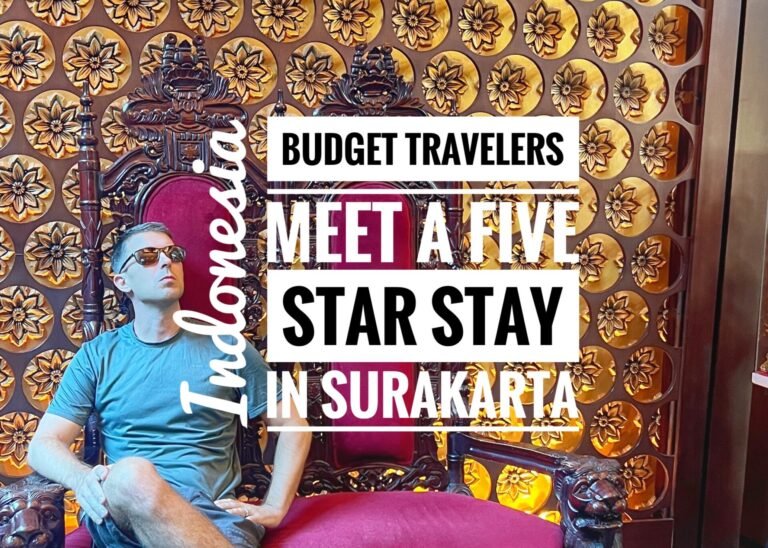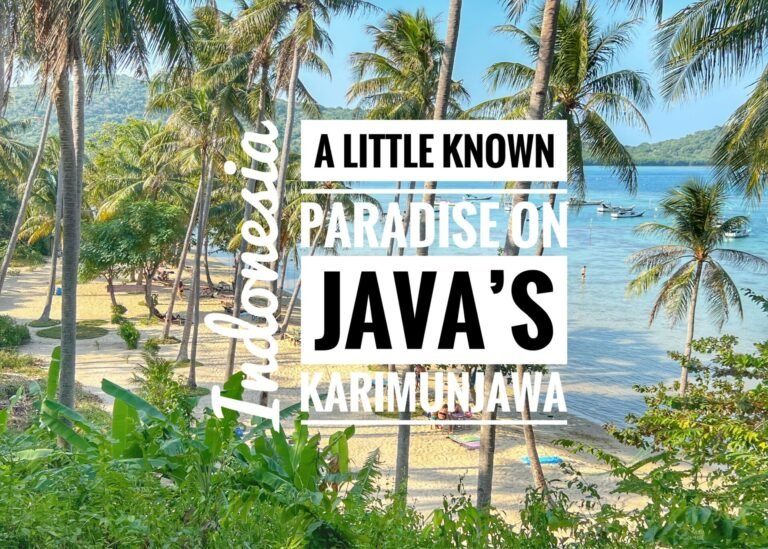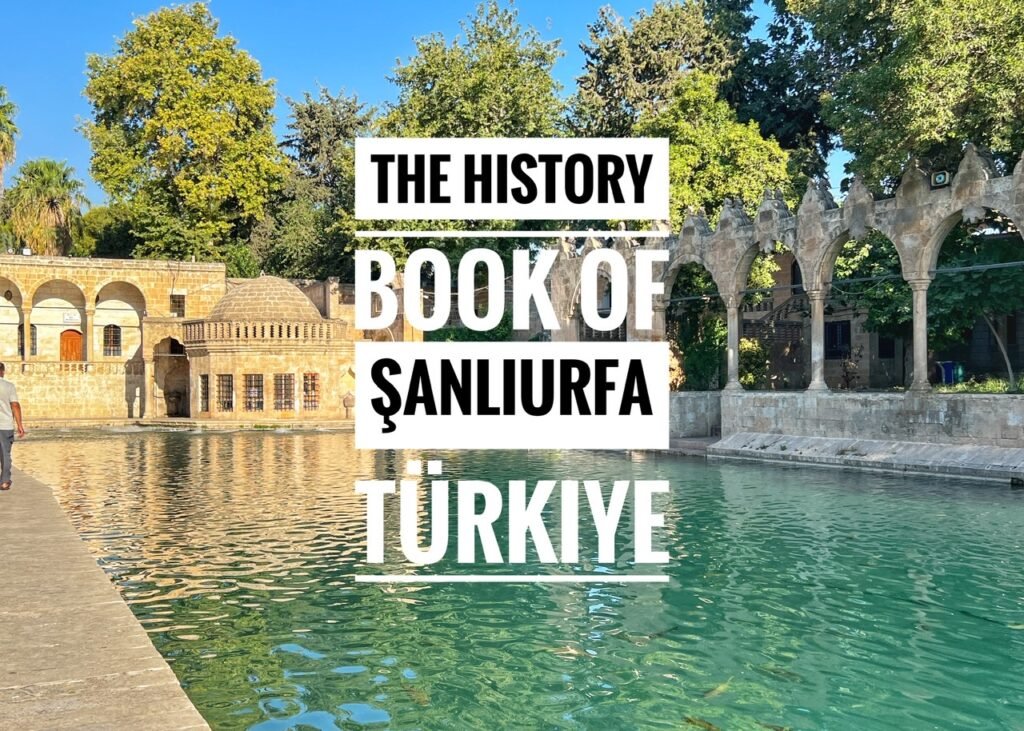
The potpourri of cardamom and other exotic smells permeate the air as you amble through the most authentic souk in Turkiye….the sounds of men chattering in a mix of Turkish and Arabic over tea comingles with the haunting call to prayer…the sights of women in various degrees of sheathing sashay by collections of pint-sized tables and chairs which look like they’re meant for a children’s birthday party.
We’re not in Tourist Land Turkiye anymore Toto! In fact, Lonely Planet sadly doesn’t even give the gem of Sanliurfa a nod. Quite a pity because with a history going back 12,000 years, stepping into former Edessa, aka Sanliurfa, aka Urfa, could not feel more far away from the worlds of Istanbul and Cappadocia. In fact, it showcases exactly the slice of Türkiye we had been wanting to see…a bit more exotic, a bit more conservative, a bit more authentic and way more off the beaten path. Also, according to the Old Testament, this city is also where the father of the three most prevalent monotheistic religions was born…welcome to the hometown of Prophet Abraham.

But, first we had to get there. This river may look like any ‘ol river, but we assure you, it is not. On September 10, sitting with anticipation in our blessedly air conditioned dolmus (mini bus), we crossed into the real life history book of southeastern Türkiye as we traversed the Euphrates River.
The Euphrates, along with the Tigris, is one of two defining rivers in ancient Mesopotamia. They provided the water to the Fertile Crescent which led to the first blooming of civilization around 12,000 years ago.
This area (which yes, is safe) is much less frequently visited by foreign tourists and is slam-packed with names you might have heard of from the Bible, Quran or Torah. It is also often known as the “Cradle of Civilization,” shared with Syria and Iraq. It was here humans evolved from hunter gatherers to forming permanent agricultural societies. And, we couldn’t wait to start exploring it.
Our Accommodation(s)
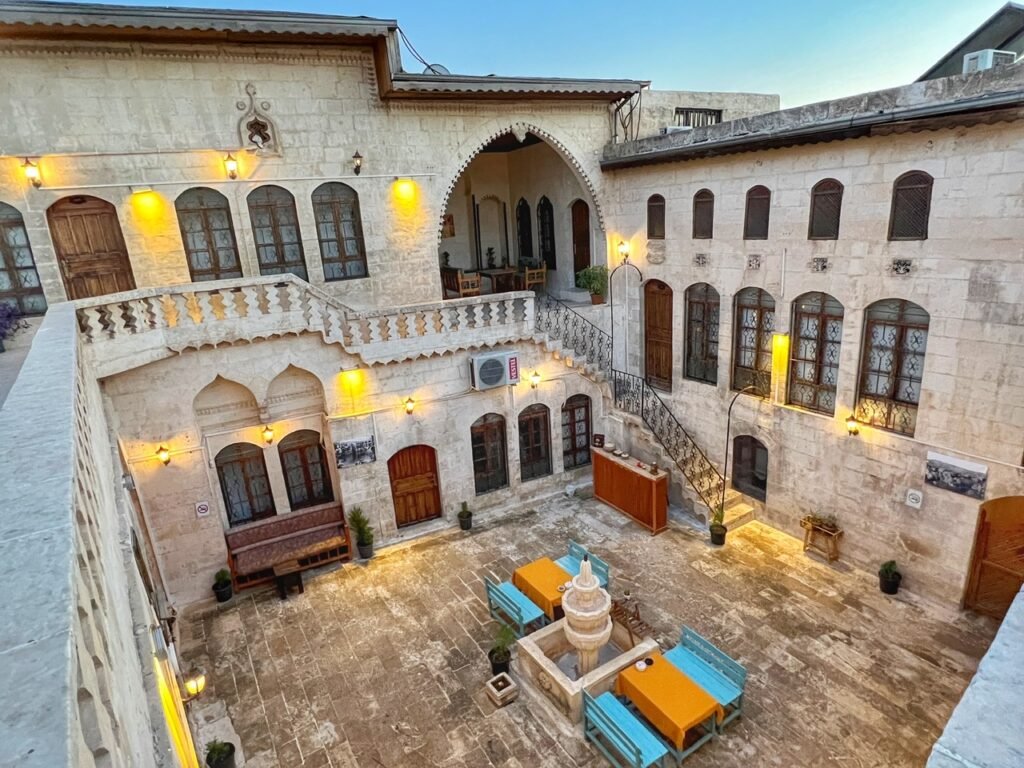
After becoming enamored with Urfa, we decided to plop down for five nights instead of three. This resulted in two similar boutique hotels, both 500+ year old former mansions and both comprised of alluring ancient stone, Islamic architecture, sweeping courtyards and with central locations. However, they held quite different price tags (32 versus 19€ per night) reminding us why we typically book a bit in advance.
Our first hotel, Şerif Paşa Butik Hotel had a simply striking courtyard and was an astounding 19€ a night on Airbnb. We are living large on our $25/night or less accommodation budget these days. The catch? Breakfast was not included, which is kind of a rarity in Türkiye.

The hand laid stonework of the arched ceilings made you feel like you were going to sleep in an Arabian palace.

We loved getting lost in the sleepy alleyways near our place.
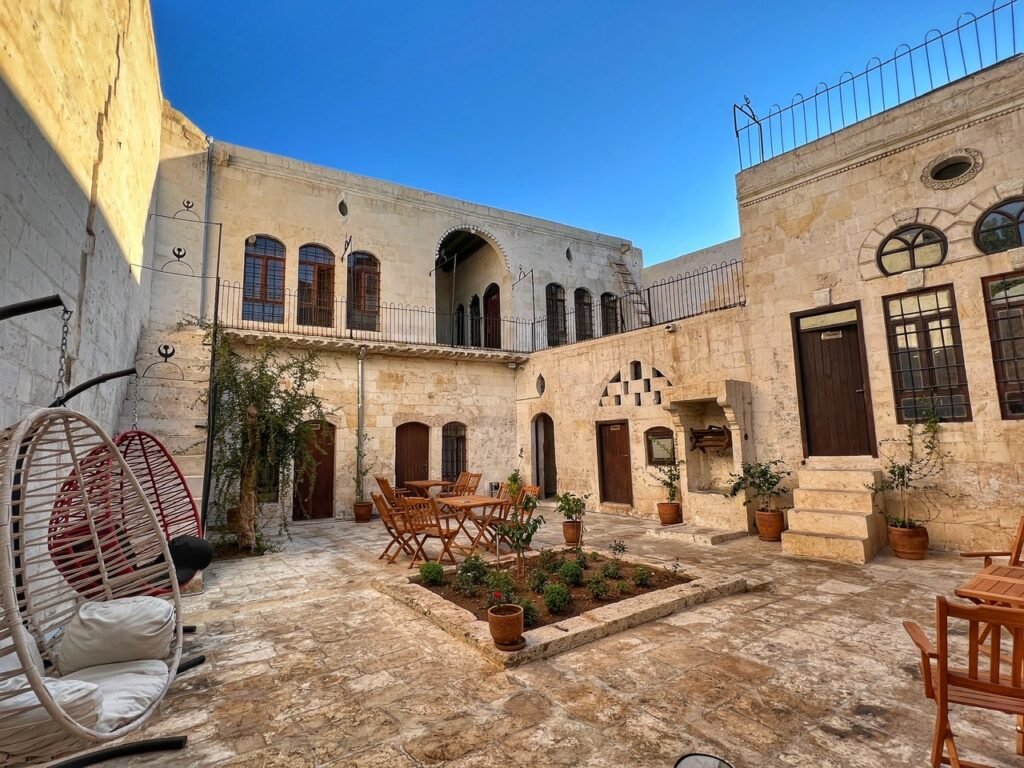
Our other place…Çiftehan Butik Otel was 32€ a night on Booking and included a fantastic breakfast which actually included yogurt. Score! (We have yet to figure out why we haven’t been served yogurt for breakfast yet when it’s clearly prevalent.) The two Gen Z’ers who ran the show didn’t seem very friendly, however, and were more interested in camping out in the hanging chairs on their phones than making an effort to smile at their guests. Ah well! ??♀️
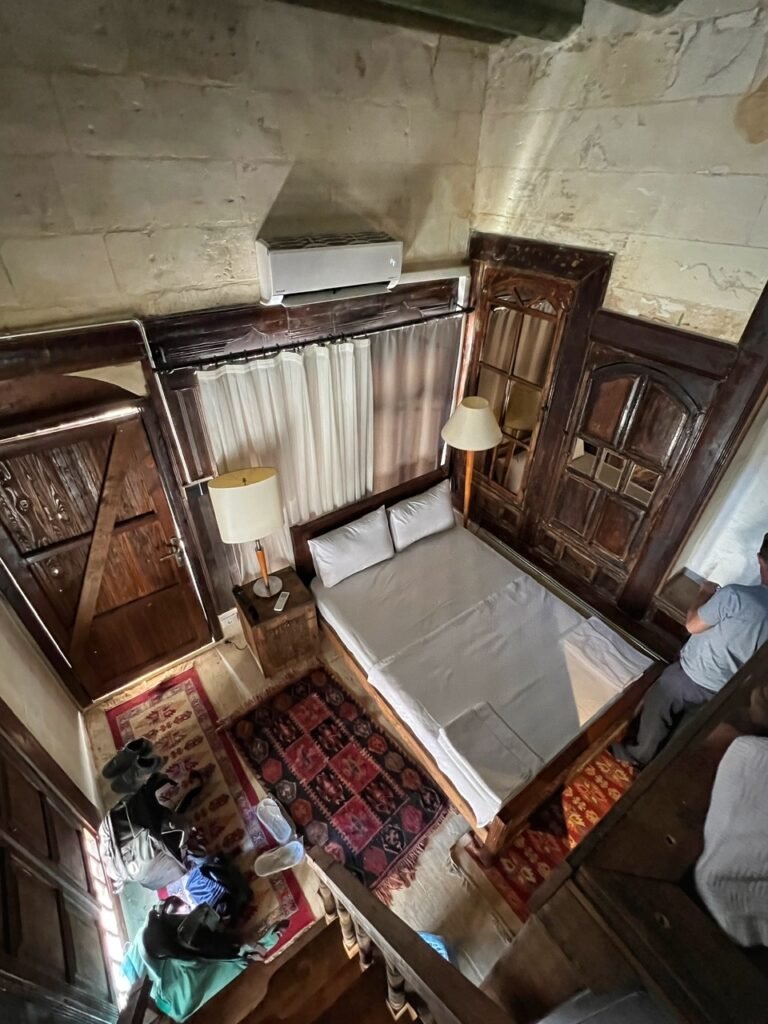
Our room here had a loft with a second bed, which resulted in soaring ceilings. We loved the dark wood and ridiculously fast internet!
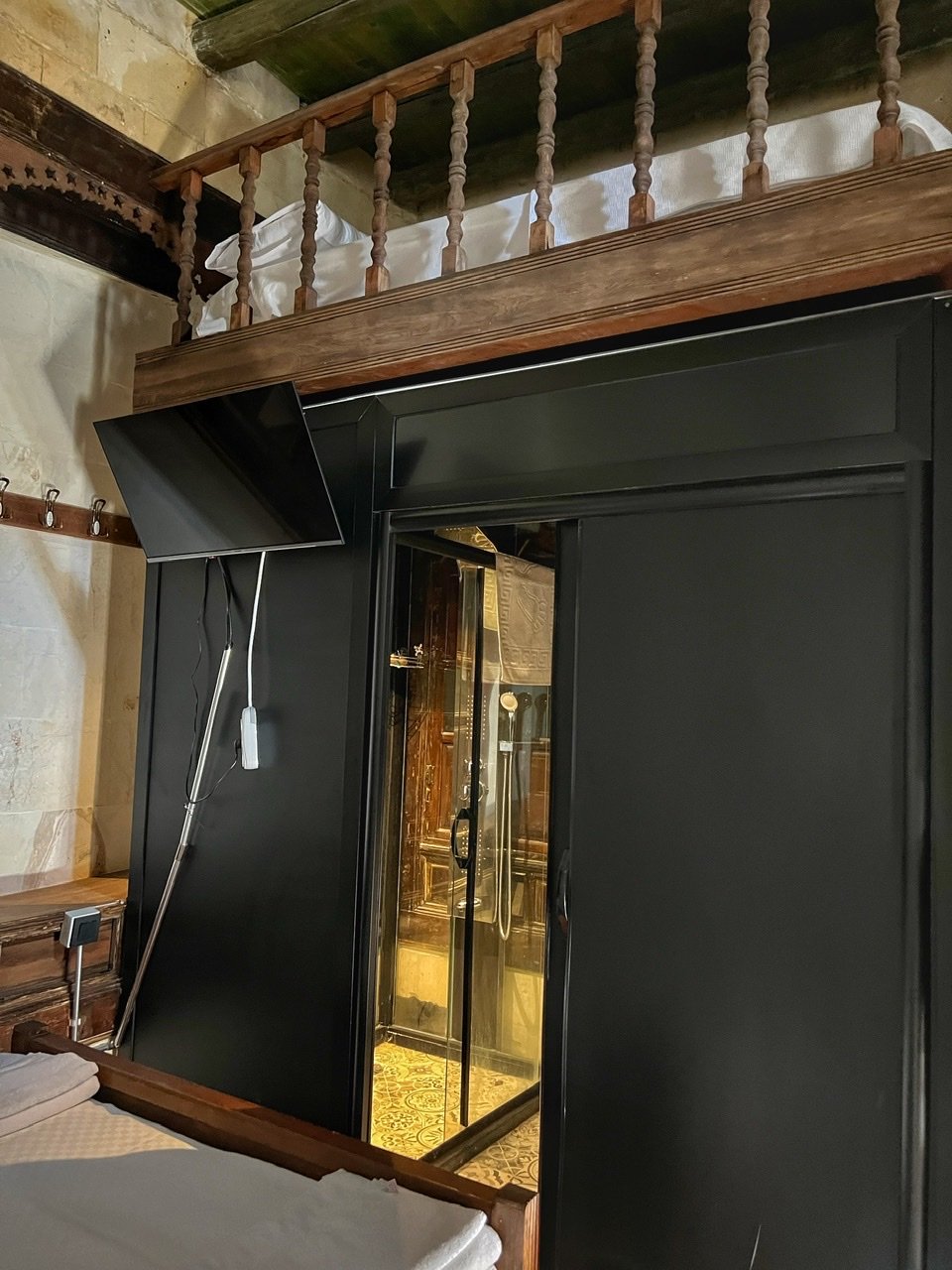
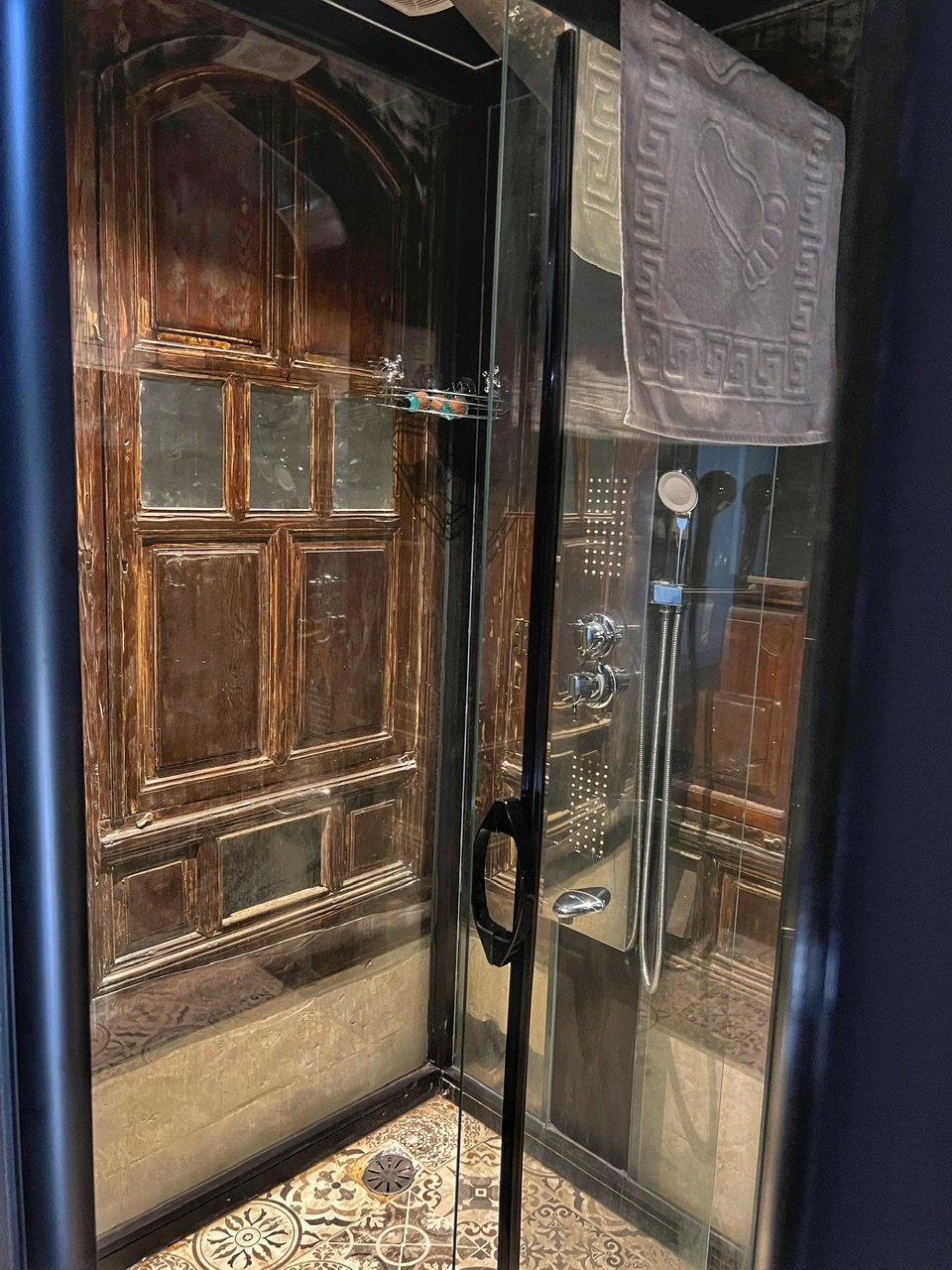
We also found the modern “bathroom in a box” concept a bit fascinating in this historic room…especially when you could see right through! ? There was even a section that was windowed into the room, perfect for peeping partners.
Exploring Urfa

Off to explore! Prophet Abraham lived around 2000 BC. In the Bible (not sure about Quran), he is most known for his faith and his readiness to kill his own son in the name of God. Abraham also rejected the claim that Nimrod, the ruler of Urfa, was God. Abraham destroyed statues worshipped by the inhabitants of Urfa and publicly defied their gods. A great fire was lit on the place where the lake can now be seen. As the story goes, Abraham was then tossed from a mountain into this fire and saved by God/Allah.
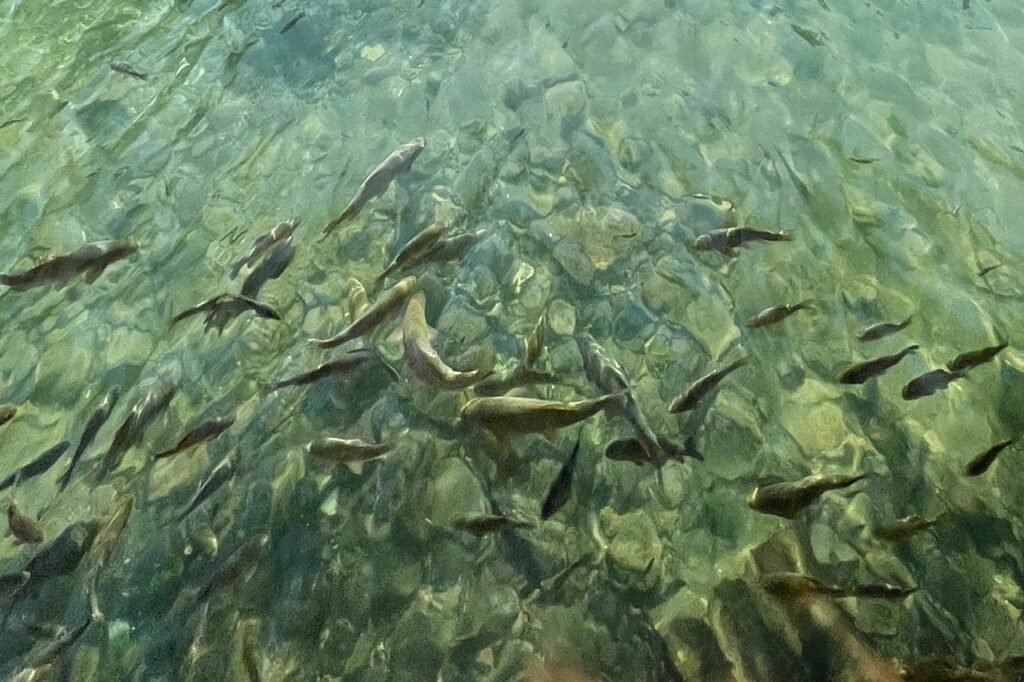
According to tradition, the place of the fire turned into water and glowing embers of the fire into goldfish. Thus, the fish in the lake are regarded as holy and are not eaten. And for the record, they are carp, not goldfish today, so perhaps they more represent cheaper cooling coals than expensive fiery flames. Visitors are encouraged to feed the carp but should you decide to kill or eat one of them, you will (obviously) go blind…
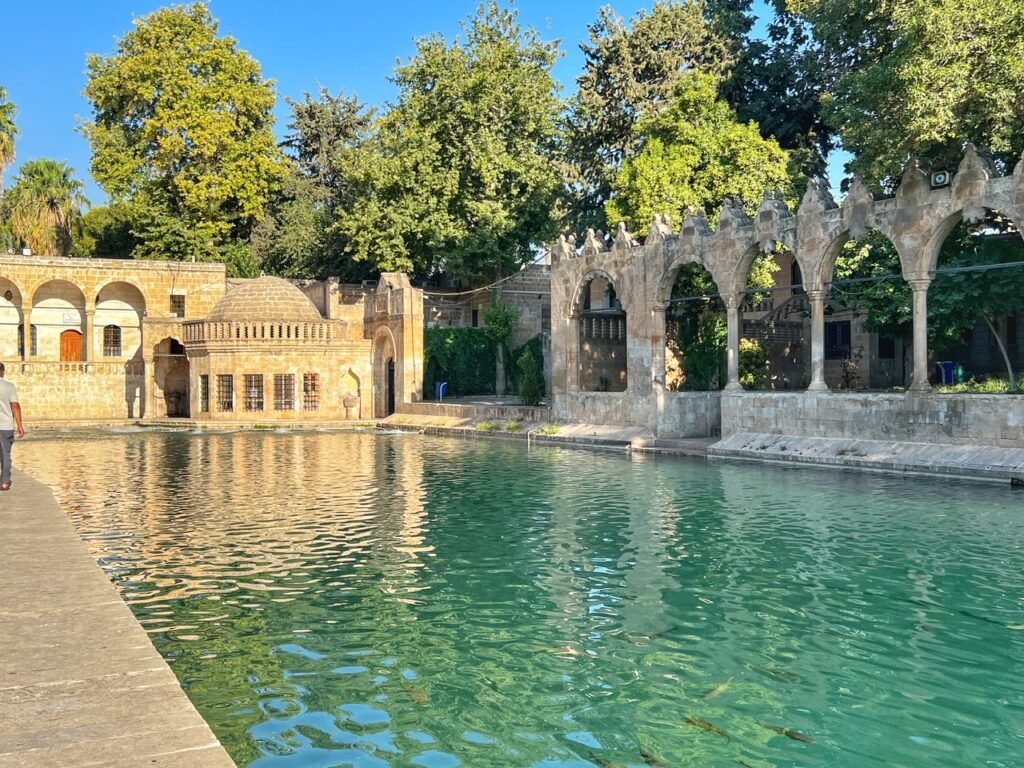
The Sacred Fish Ponds (balıklı göl) are surrounded by the beautiful Rızvaniye Vakfı Mosque and Medrese complex on their north side, and the Halilur Rahman Mosque to their west.
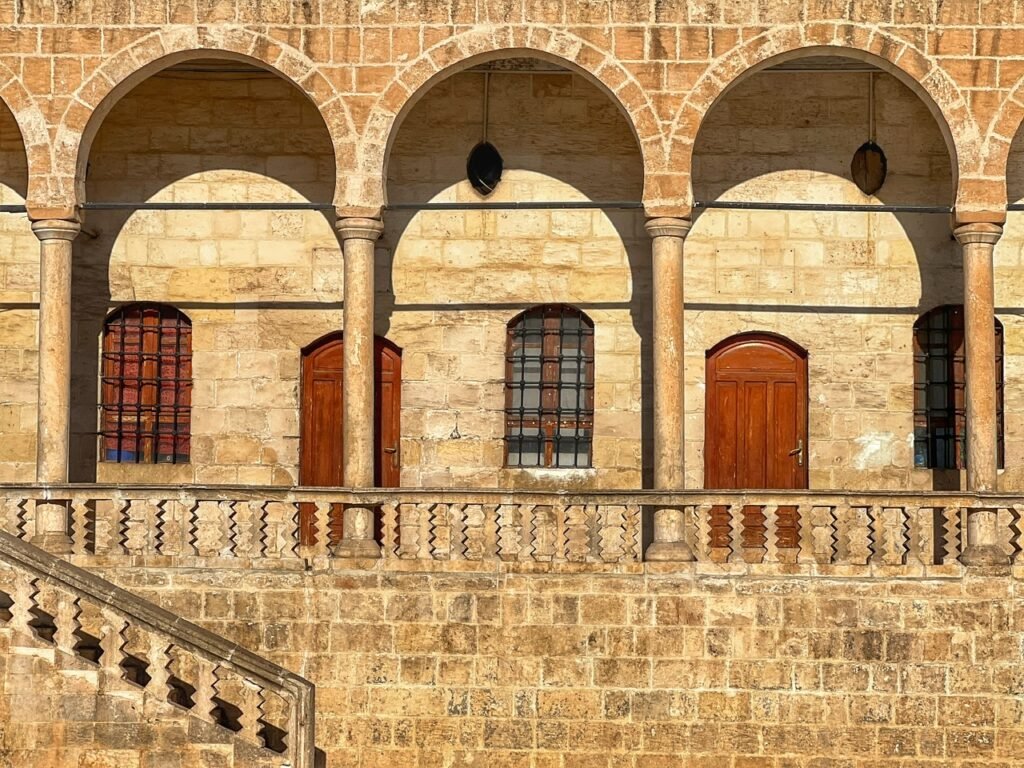
The architecture is stunning, which you can fully appreciate early in the morning before the mobs of pilgrims and local tour groups arrive.
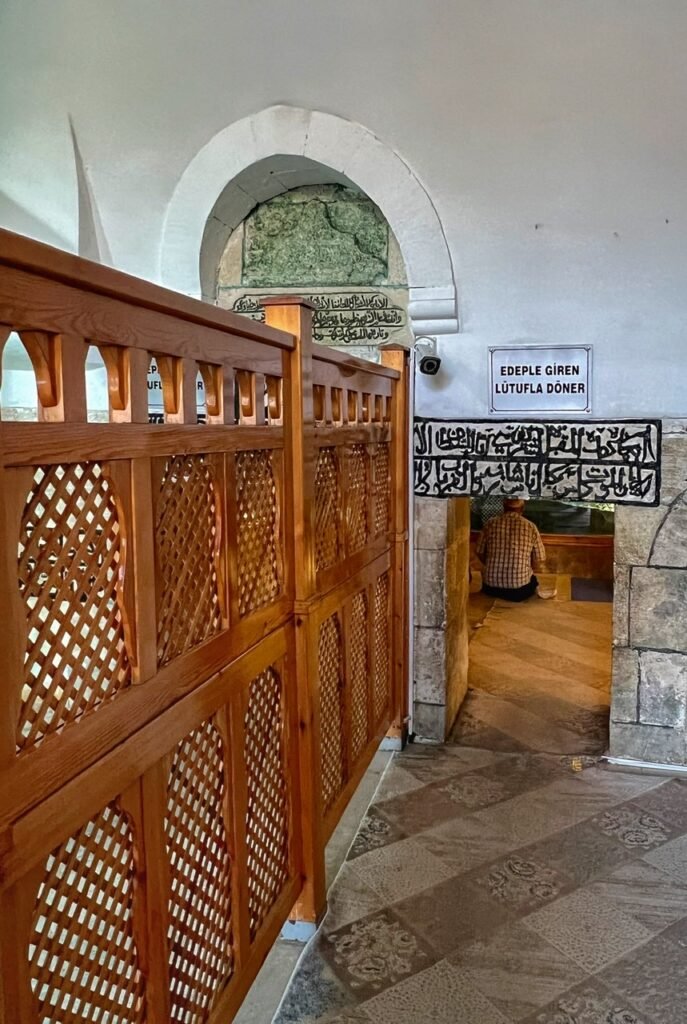
Moving on, we visited the cave in which Abraham was born, which is free. We couldn’t understand this sign but we’re pretty sure doners were not sold inside. Jokes aside, the cave is a very sacred space so proper decorum is necessary. After removing our shoes and Mandy donning her head scarf, we ducked through our discreet gender segregated entrances.
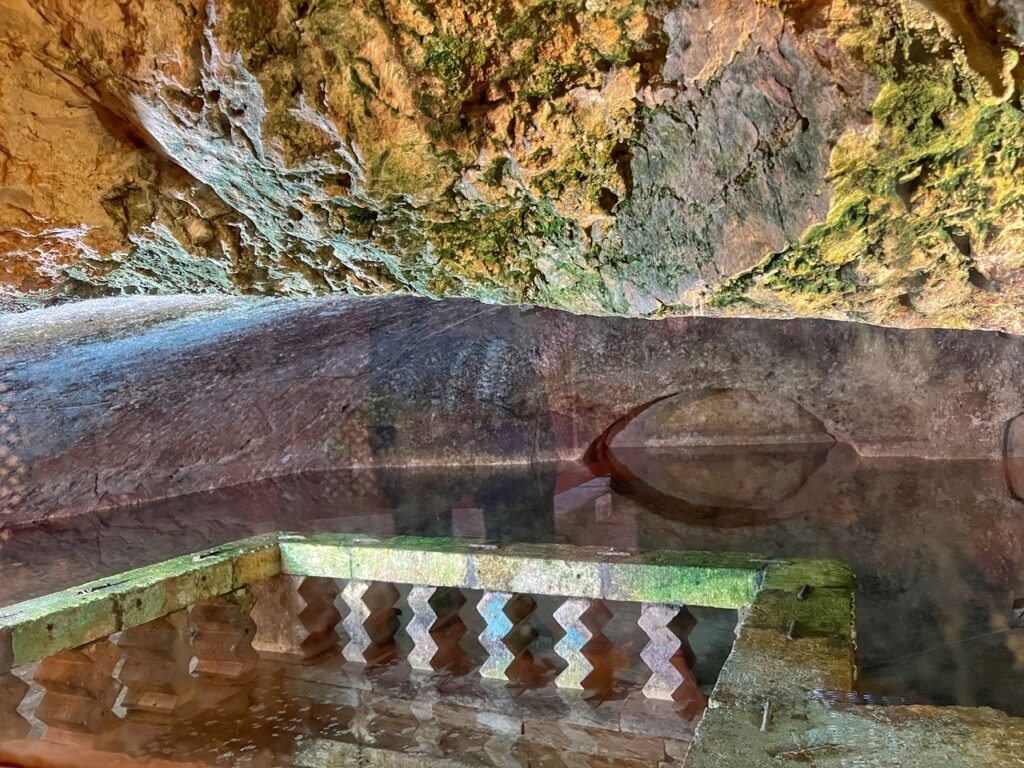
The cave was home to Abraham whose mother gave birth to him and hid him for 15 years. Why? Because the evil king Nimrod wanted to execute all newborn males who could threaten his reign, topple him from his throne, and change the Pagan religion of the time.
The ancient cave is currently flooded with ground water, and viewing is space quite limited, but was vacant when Mandy entered.


The entrance to the cave with a sea of pigeons before it. It was a very good idea to get here this early in the morning. The birds are replaced by people later in the day.
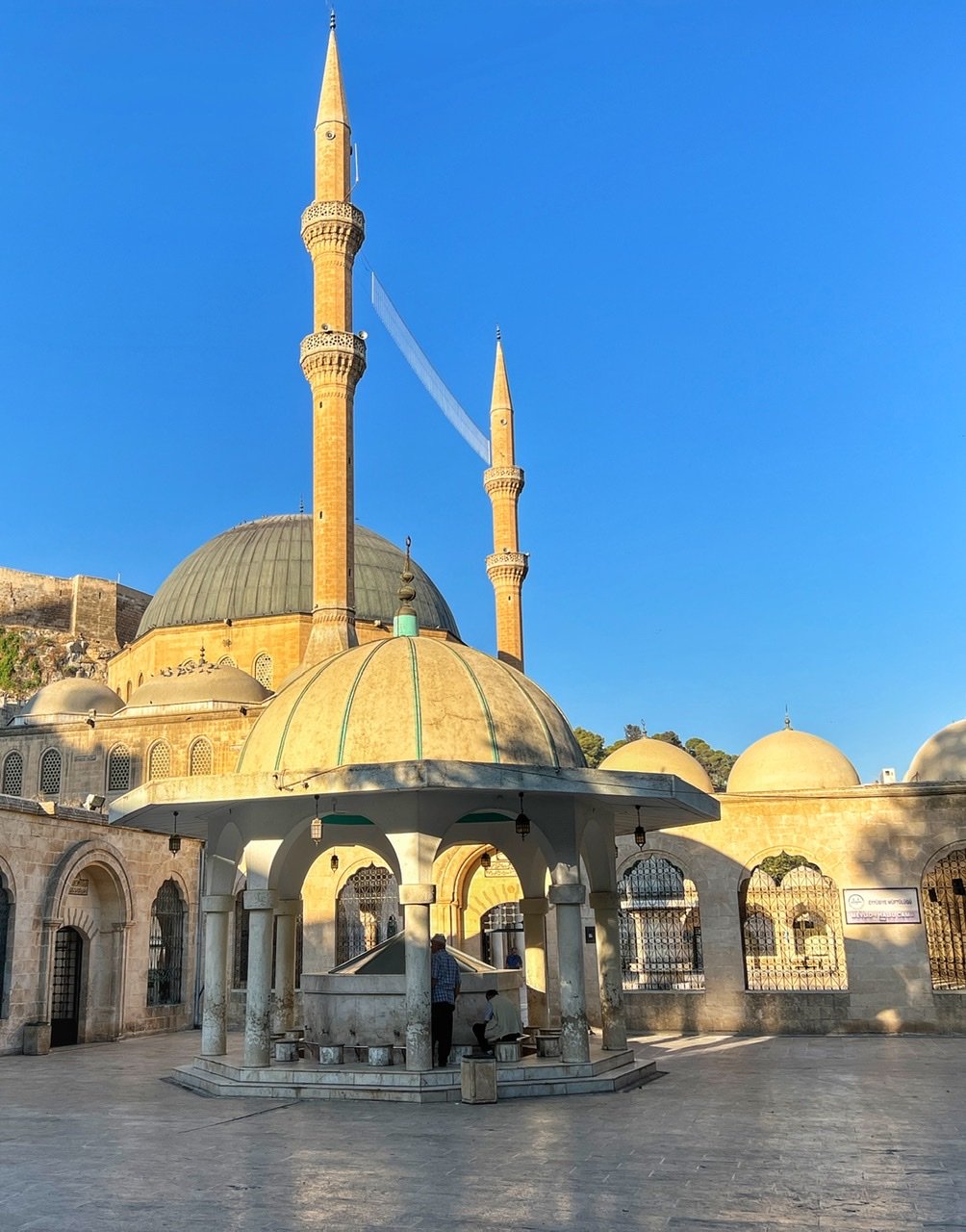
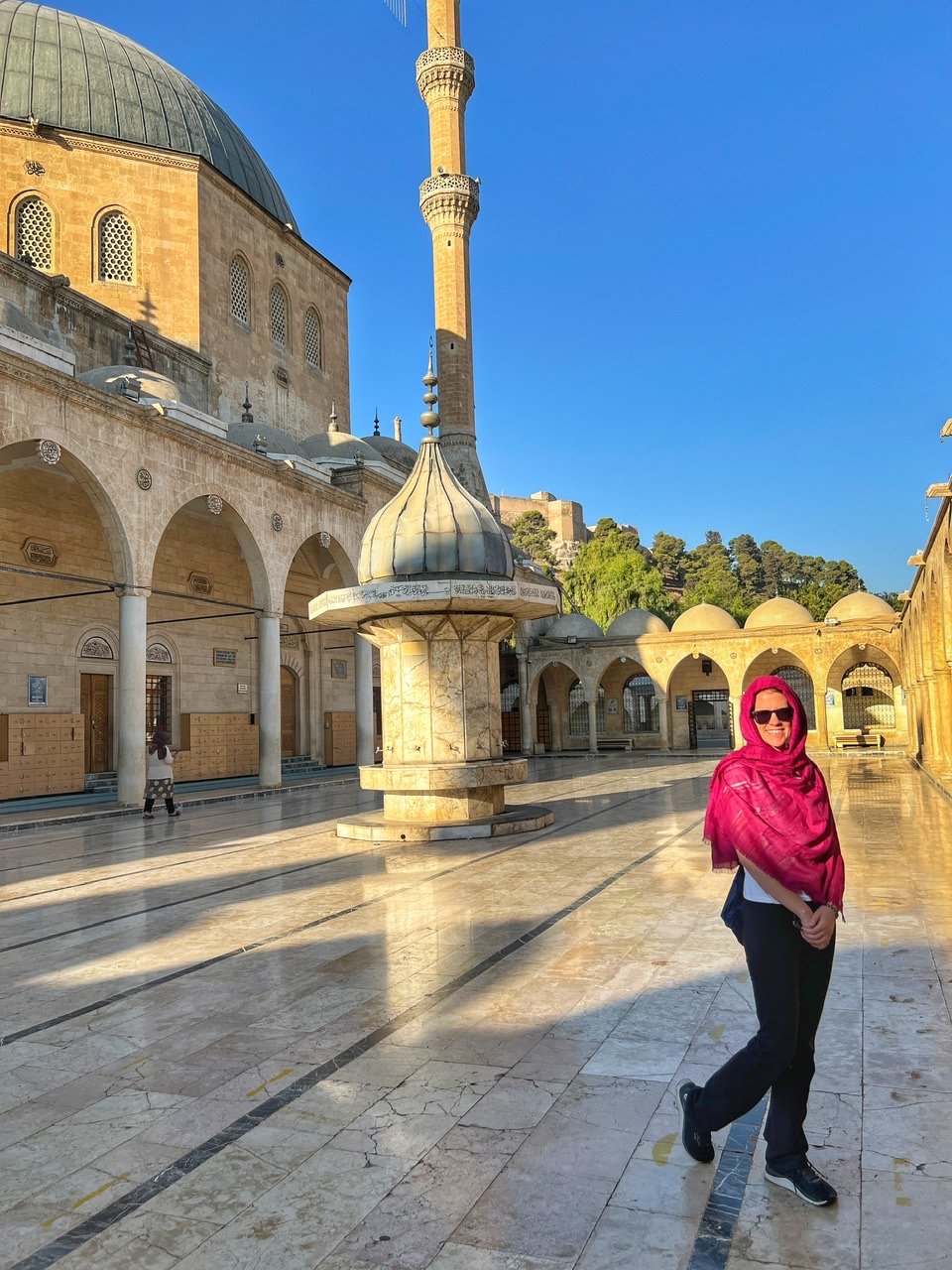
Mevlidi Halil Mosque, next to the cave, is the oldest and most sacred of the mosques in Urfa. The mosque is the most ancient of the mosques located in the city center of Urfa province. To really speak to the monotheistic developments in this area, it has remarkably been transformed from a synagogue to a church, and finally in 1523, a mosque.

Floating above the mosque is the Urfa Castle, which was built on a Neolithic site dating back to 10,000 BC. The two columns on the castle were built as monument columns during the period of Manu IX, the King of Urfa, between 240-242 AD. Unfortunately, the castle is currently closed to the public as it is unsafe.

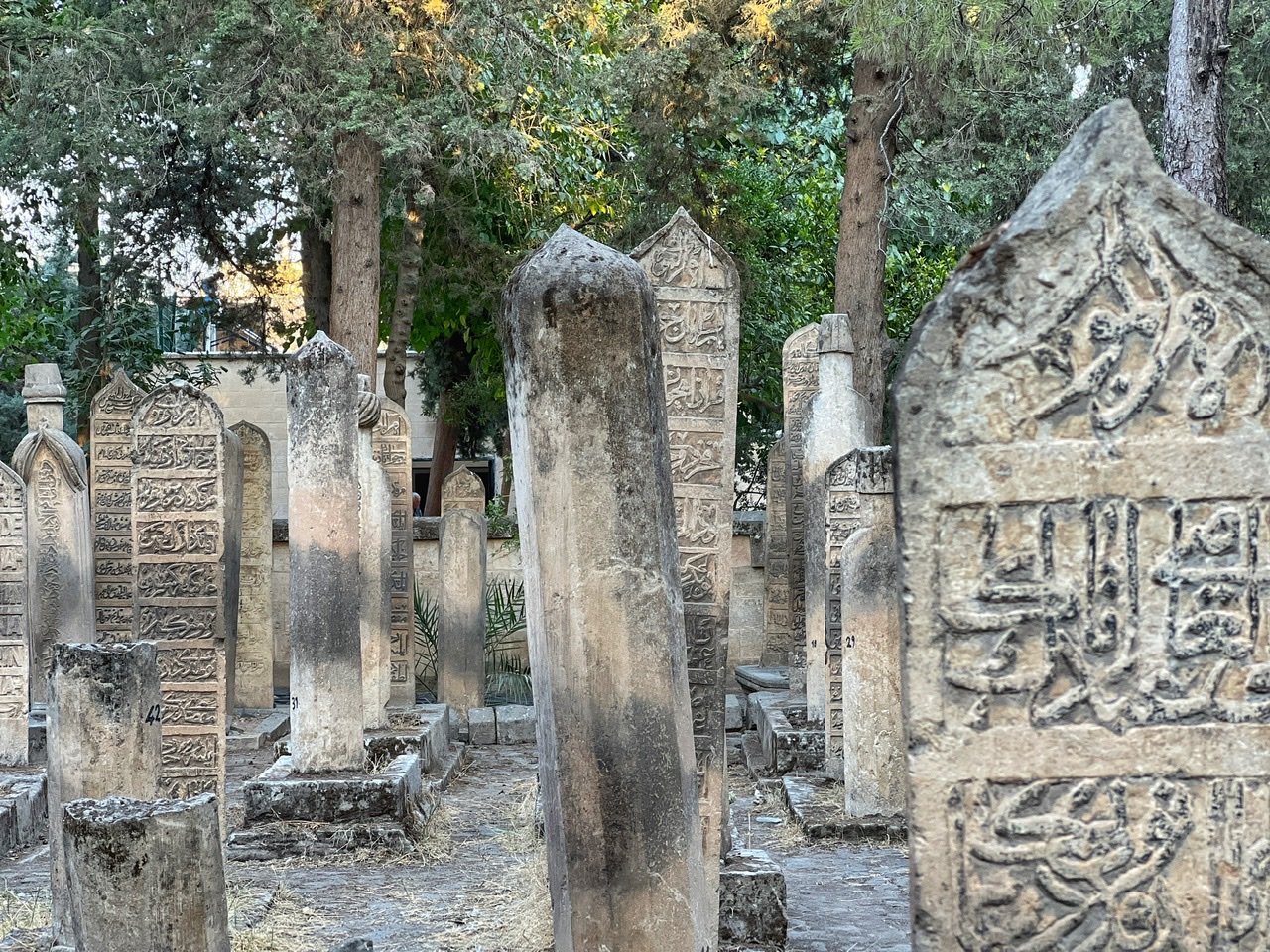
Inside the grounds of the Ulu Mosque from 1170 – 1175, which is the oldest mosque in Urfa. The tombs, in Arabic, are said to tell stories about the people beneath them. We tried to run one through Google Translate but didn’t have much luck.
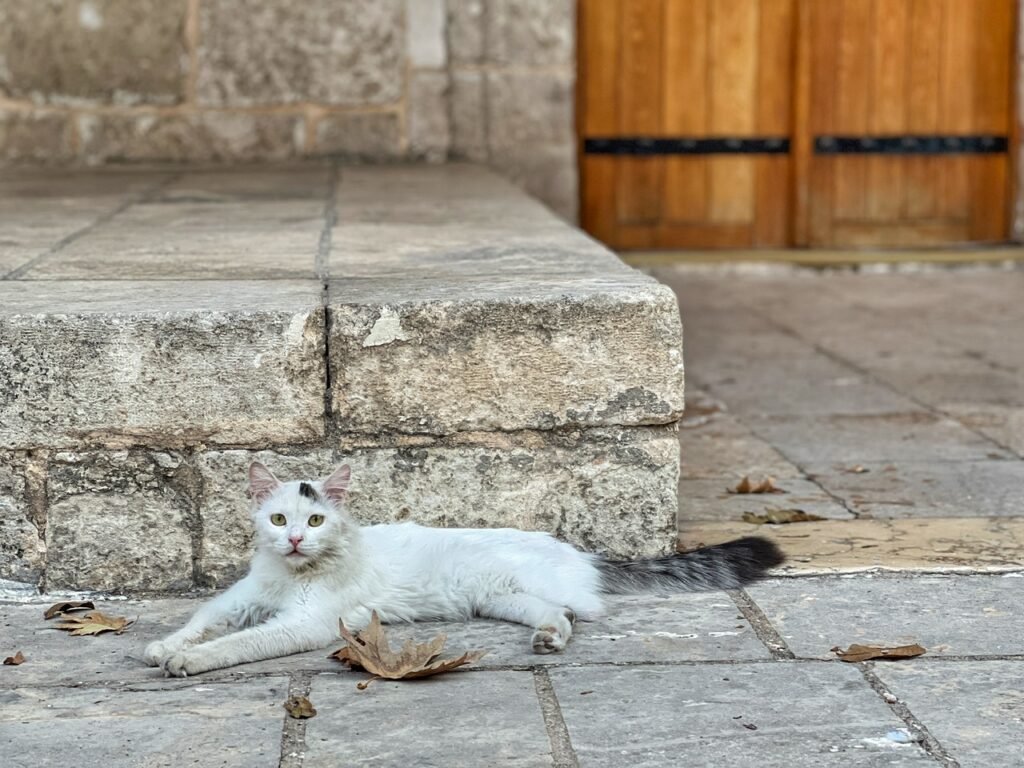
You’re always sure to find plenty of kedis (Turkish for cat!) at the mosques.
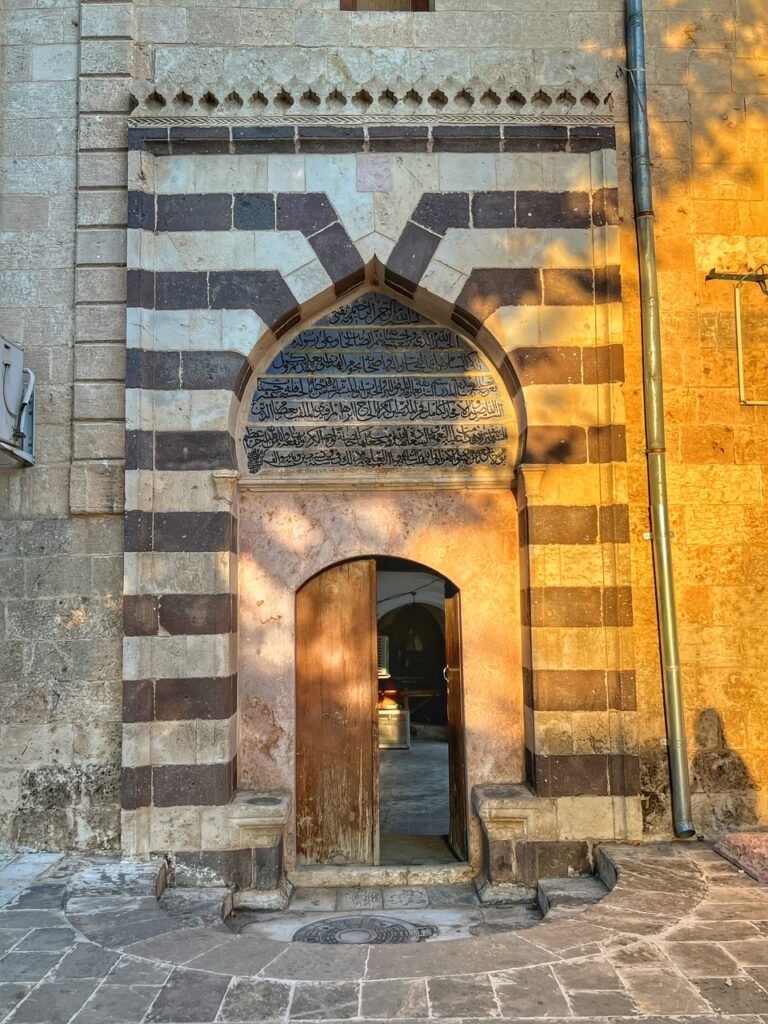
We usually went out close to sunset in Urfa as the daytime temperatures baked everything in sight.
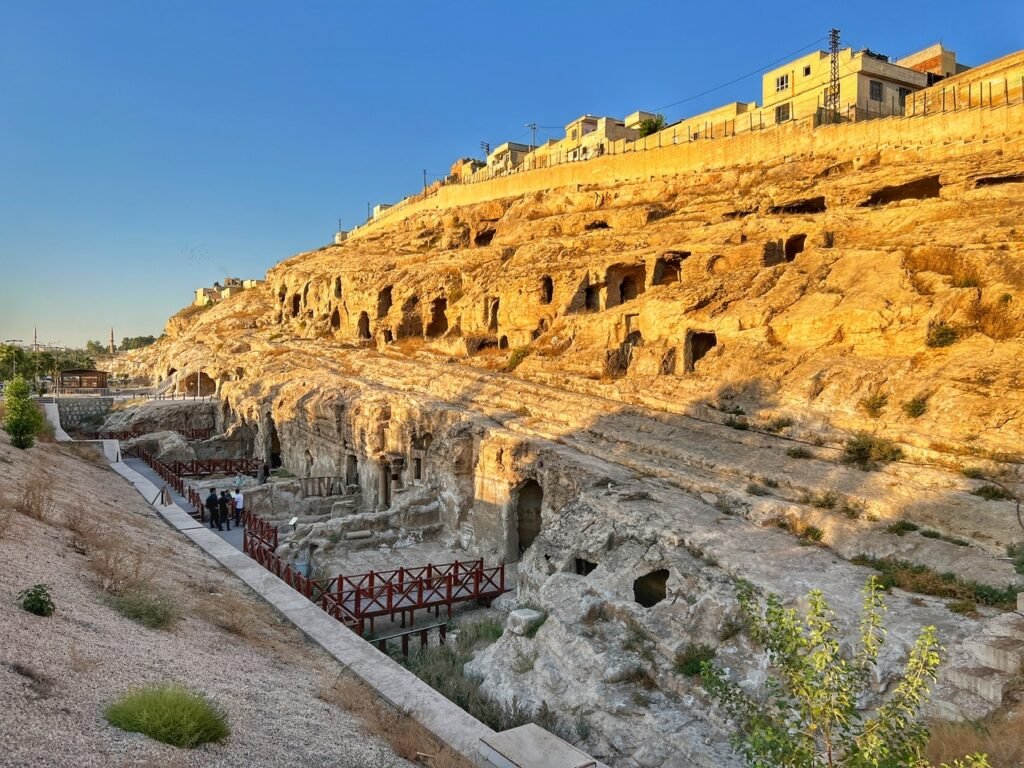
The mystical Kızılkoyun Necropolis is another impressive and free spectacle in Urfa. Carved inside a long rock, on the edge of the ancient city walls, this necropolis was built and used by the Romans for burial, likely between 3rd-4th centuries A.D. It’s also where the ancient city of Edessa was located.

Once you start gazing around, it’s east to spot the Roman influence. There’s even a centaur making an appearance!
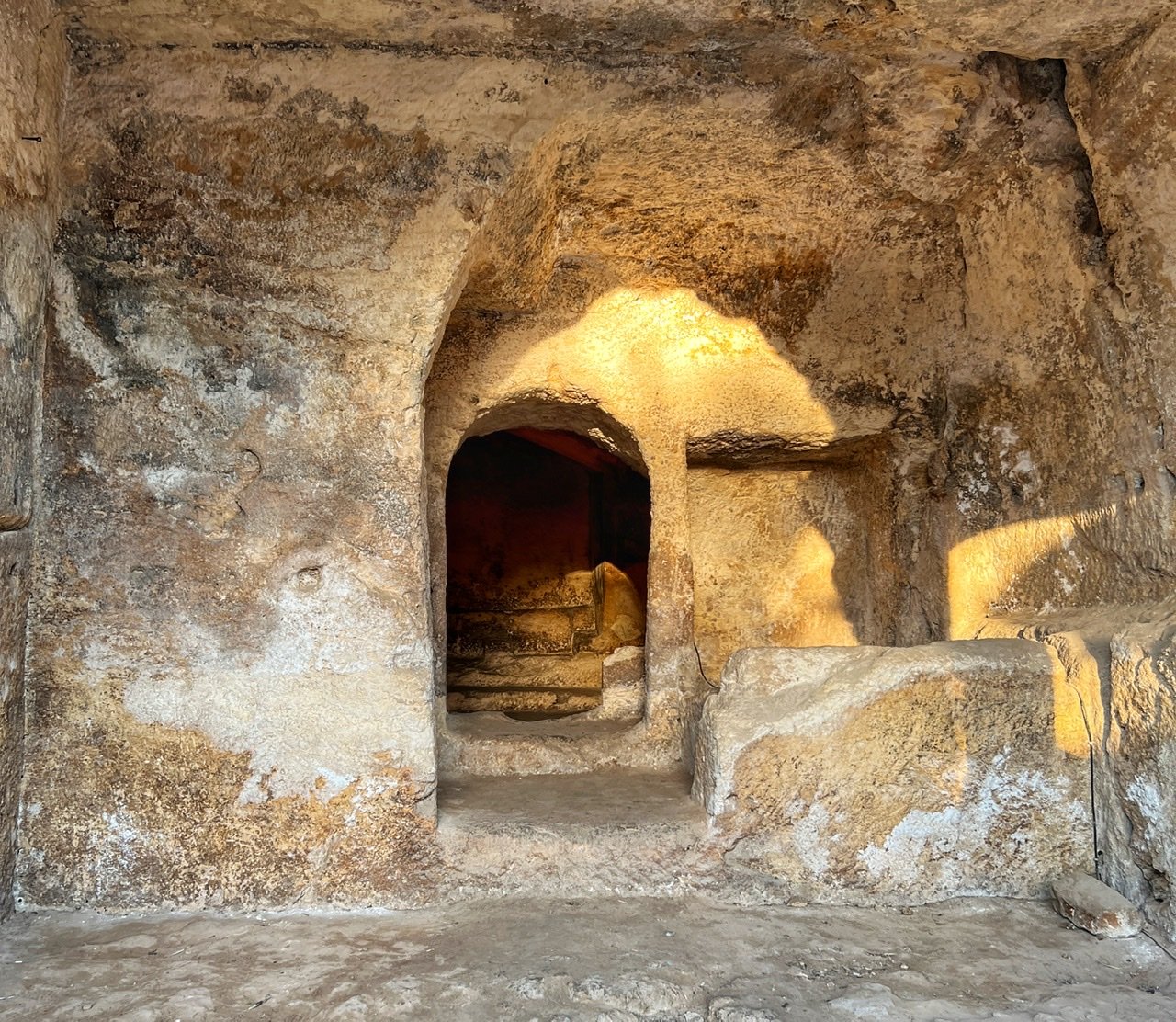
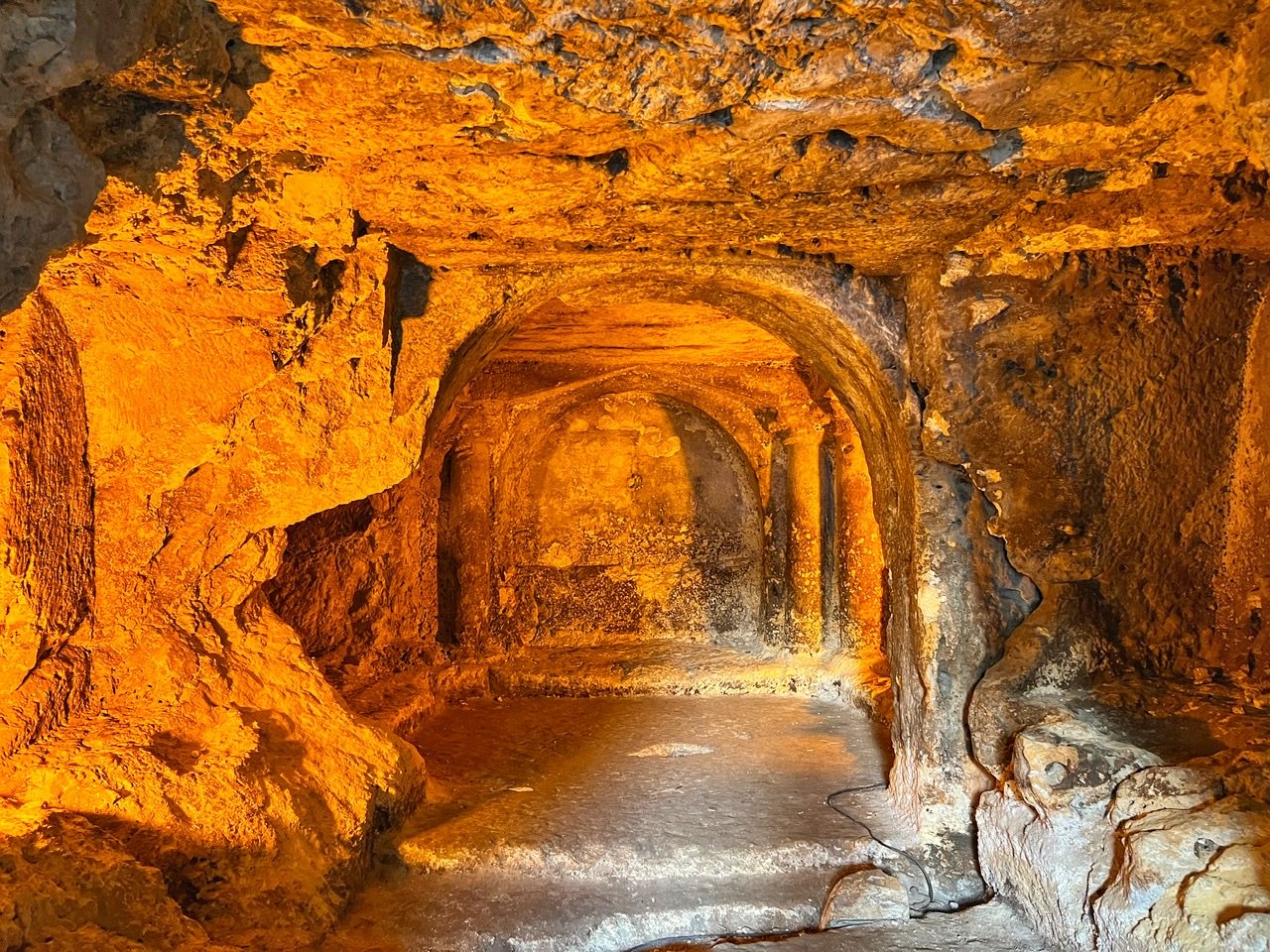
There are a variety of cave structures to peep inside often bedecked with Roman columns.
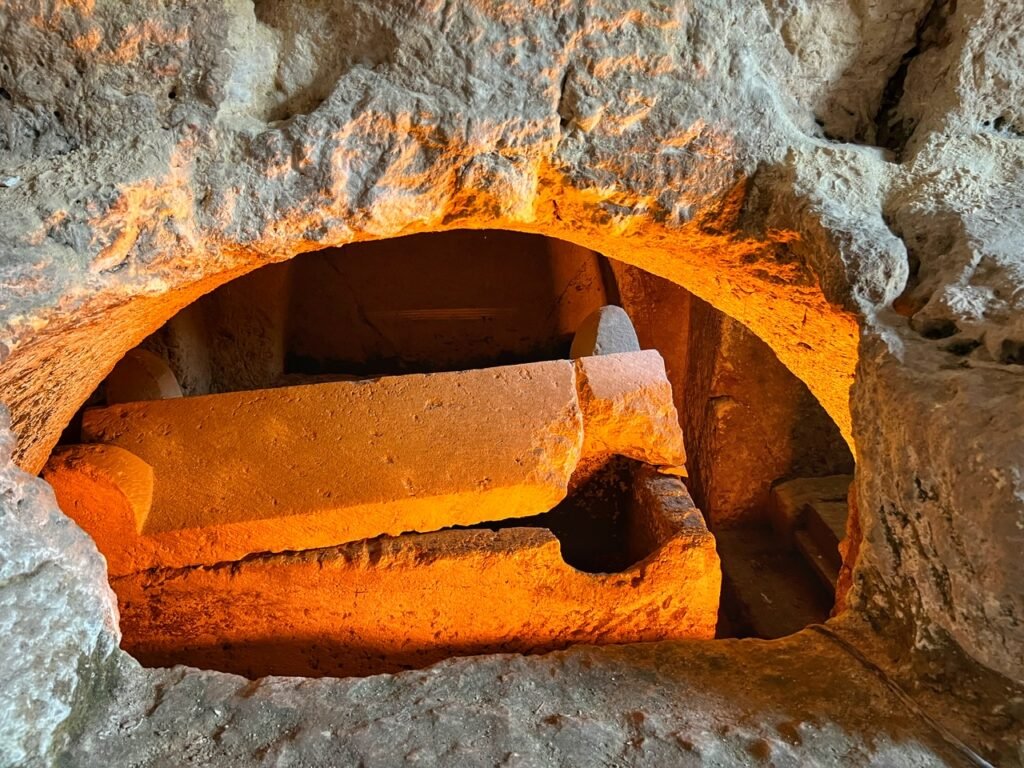
I see a broken clothes pin in this empty sarcophagus. There were plenty sarcophagi tossed about. So much for rest in peace.
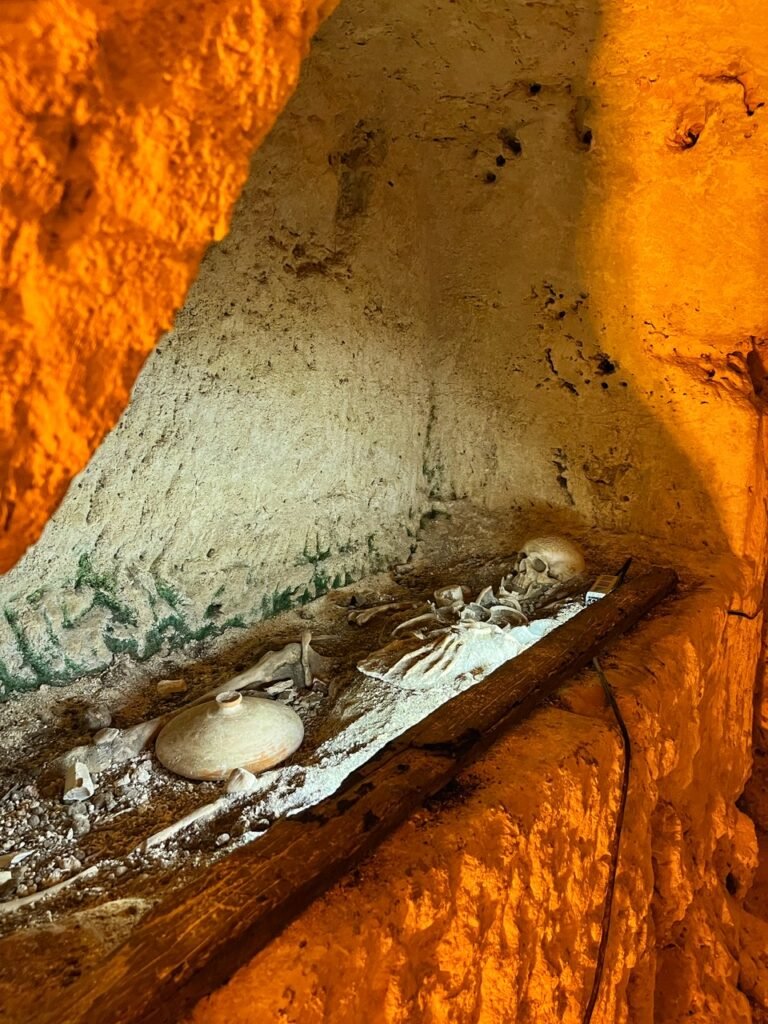
He’s not real. Don’t fret.
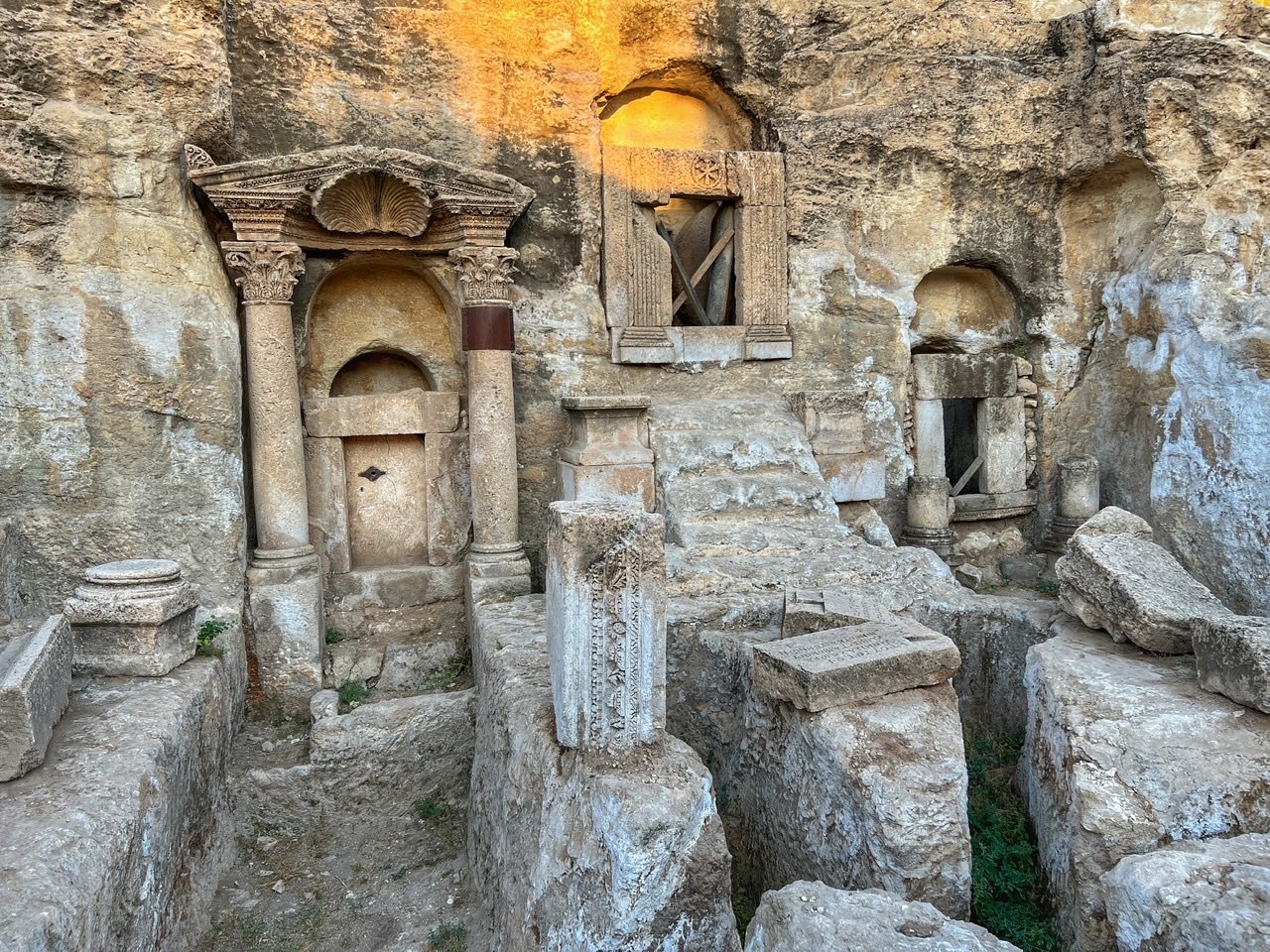
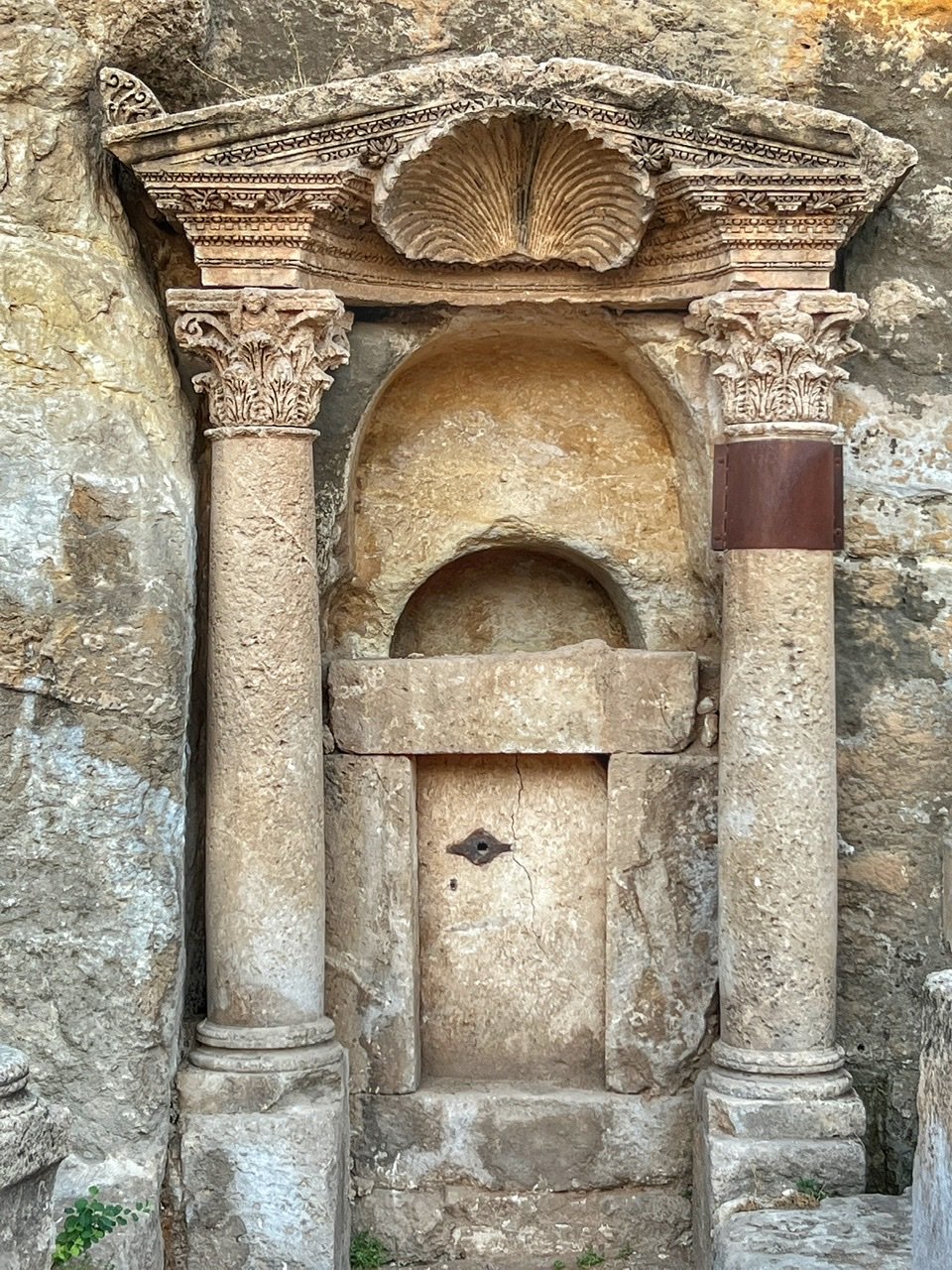
This was one of the few tombs that was still visibly accessorized on the exterior. The clam shell is said to ward off evil spirits

And the tablets proclaim who was once buried inside (no one we know ?).
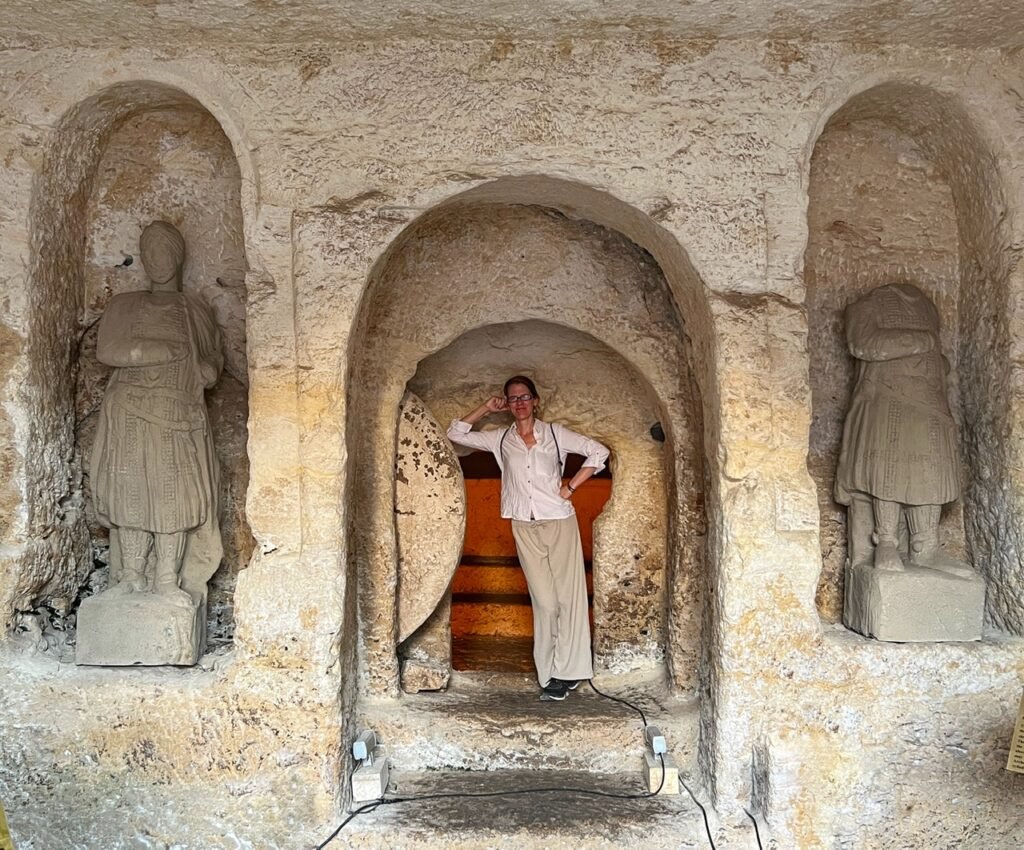
Once again, these rolling stone Temple of Doom style doors are a wee bit cumbersome.
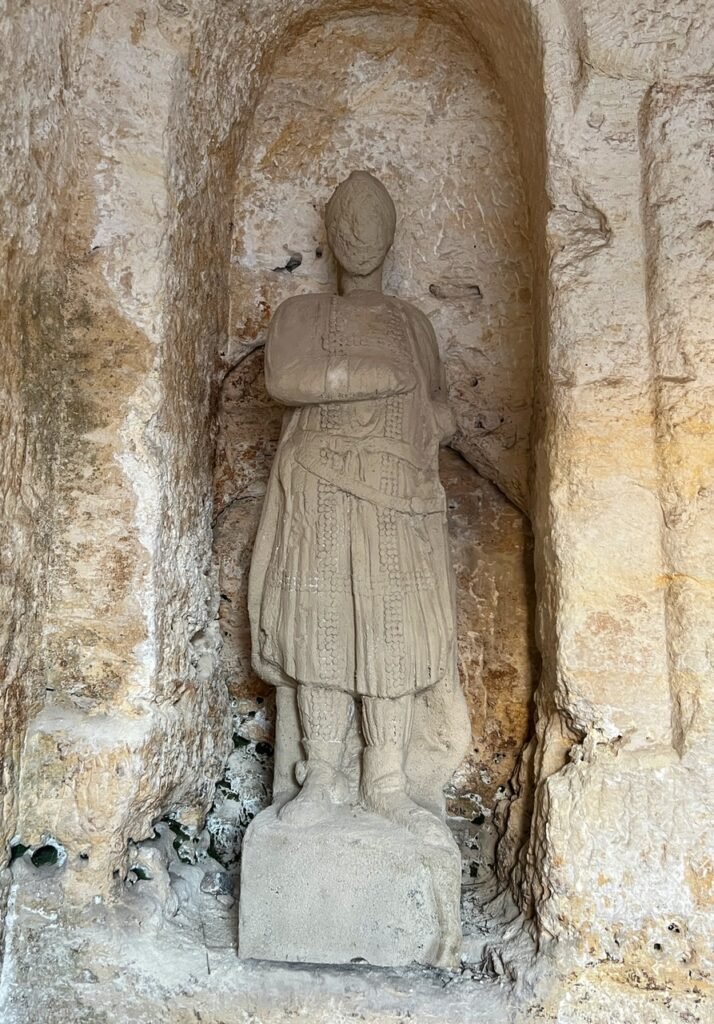
These guard statues give a pretty good idea of the military uniform of that day.


Mandy “heading home” through stone passages and tunnels.
Life in Urfa
Urfa was a tremendous treat for the senses and we undoubtedly looked at it with as much curiosity as it looked at us. We felt gazes on us more often than normal in Türkiye accompanied by apprehensive smiles and welcomes with no one hawking or taking advantage of us (at least not in an obvious way!) It was clear by their reaction that Euro-looking tourists don’t appear too often and they seemed even more surprised when we tried to speak a bit of Turkish to them. All in all, simply an unmissable part of the country.
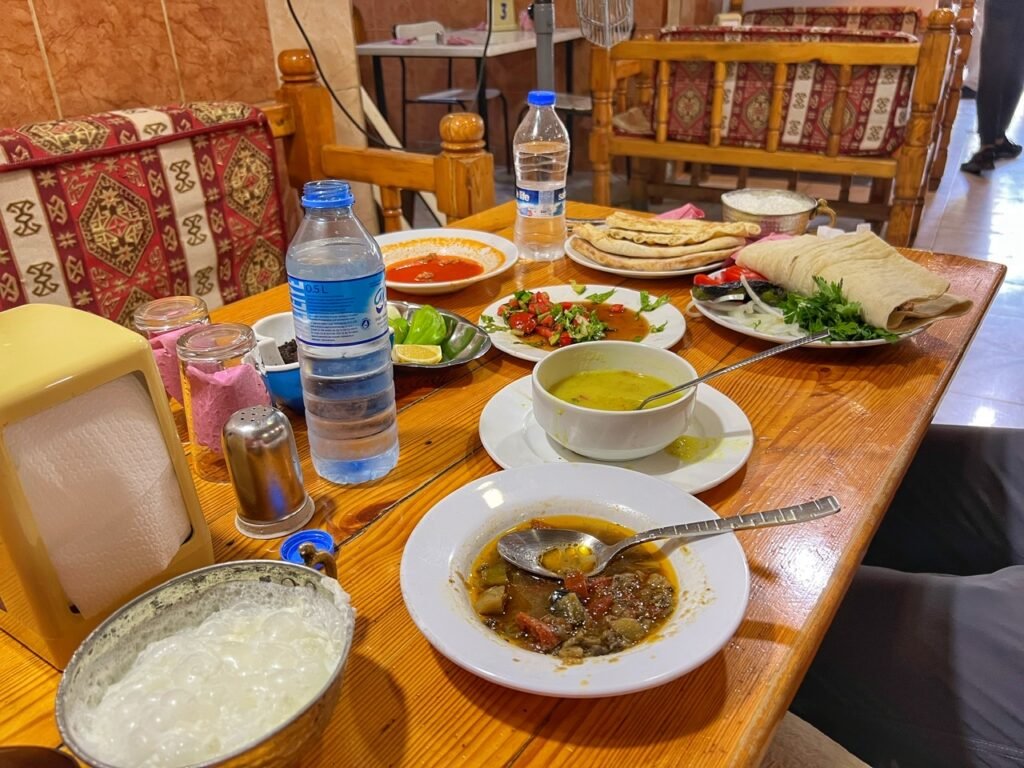
Indulging in our first meal at Altındag Lokantası in Urfa. Two soups, two salads, eggplant & veggie mix, a chicken Doner, two ayrans and two waters for 135 Liras or about $7.50. We were quite surprised when the owner began speaking English to us with a hearty welcome as we had hardly heard it since we left Cappadocia. We liked this place so much that we went back three times…
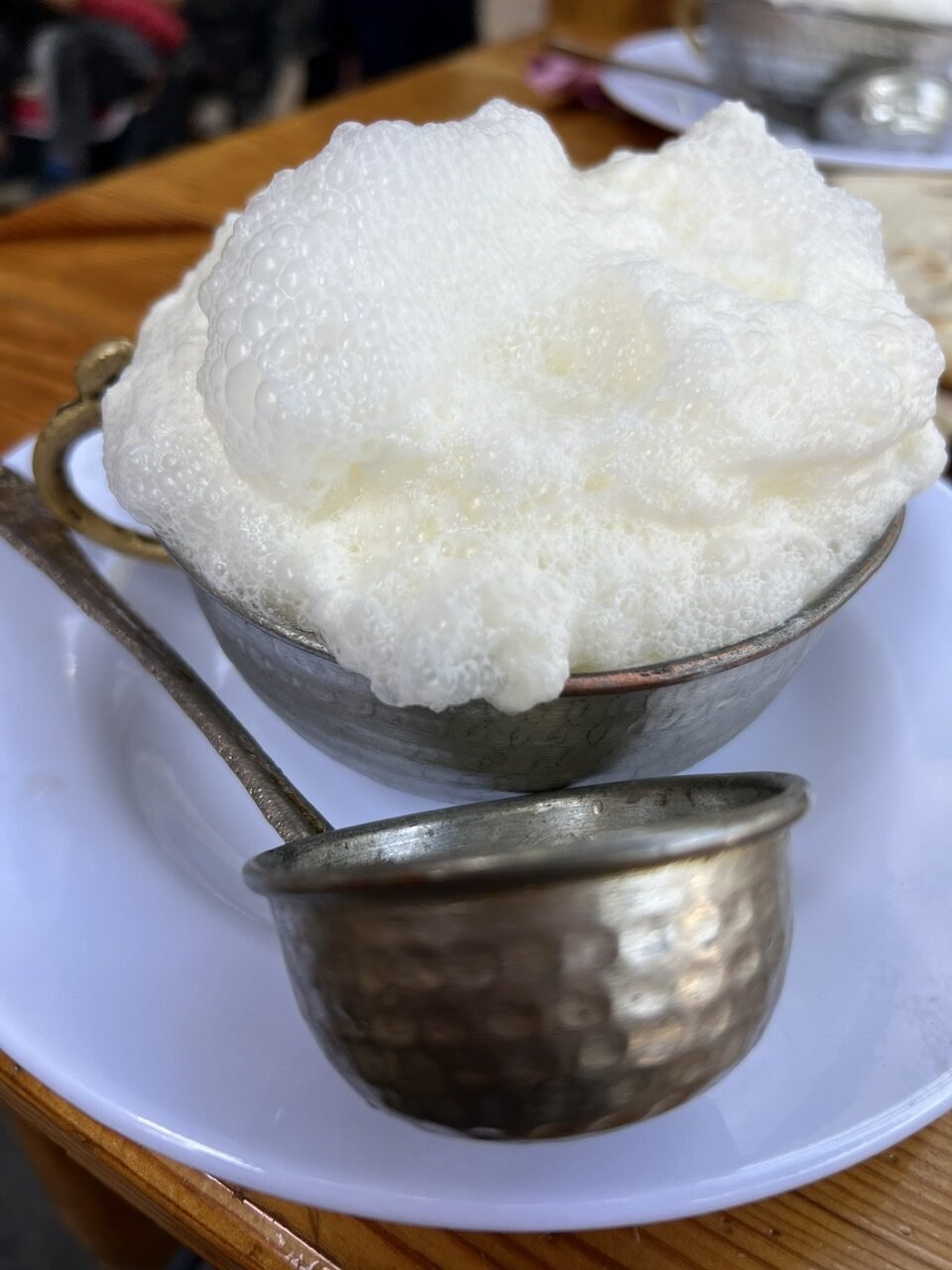
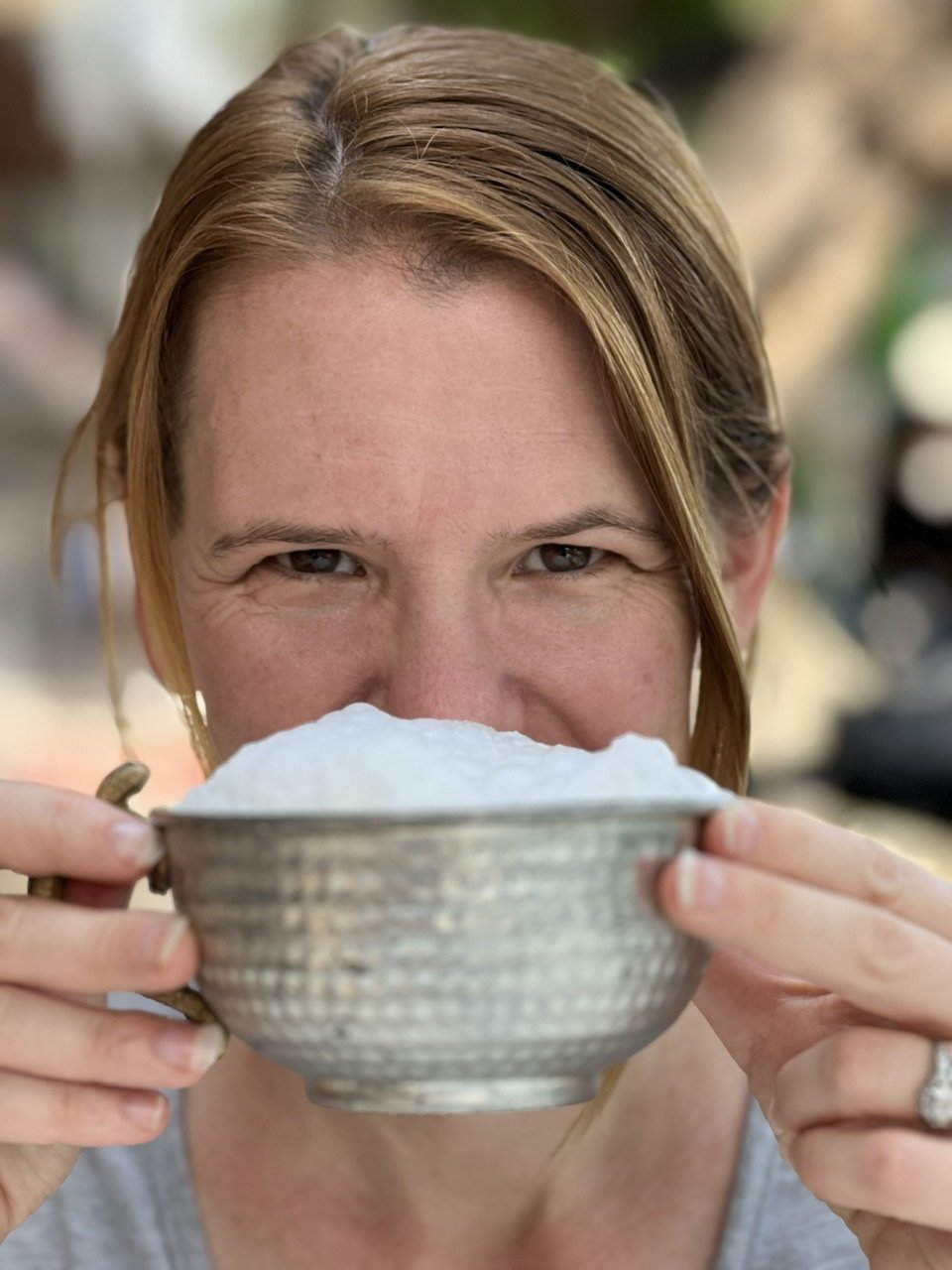
Of course a big part of this was the “Yayik Aryan” out of the fountain in a cute cup made for the Middle Ages. We’re totally addicted. Especially Mandy. No probiotic shortages in these guts!

Men having tea in saddle style chairs.
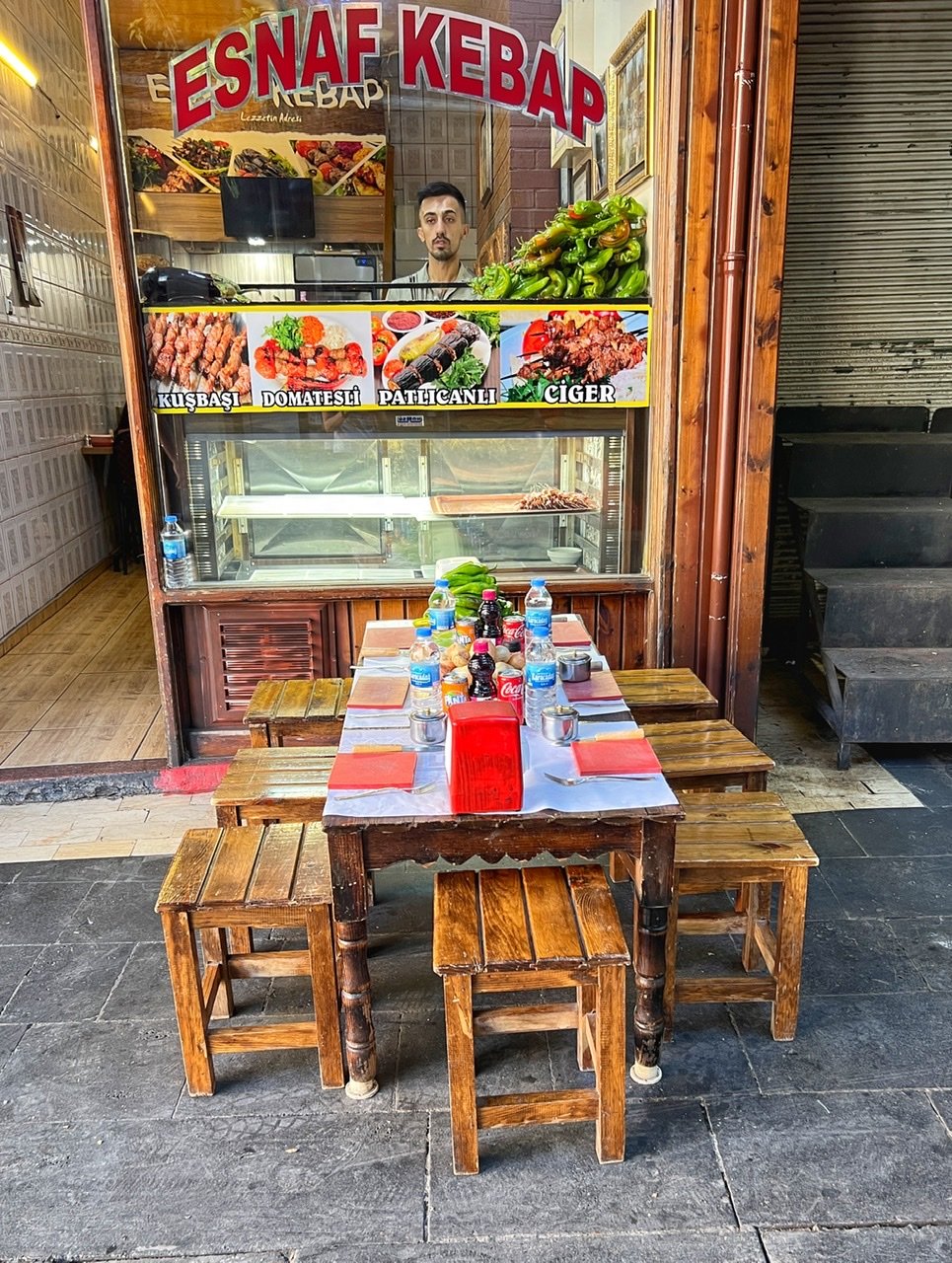

Tiny tables meant for family-style kebabs. And, Çig köfte, a regional specialty born in Sanliurfa. Typically served as an appetizer, it was traditionally made with raw meat and squeezed by hands (hence the unusual presentation). However in 2009 the Turkish government banned this practice for obvious safety reasons and today the vegetarian version is made with bulgar and chickpeas. Like much of the food in eastern Türkiye, it’s got a scrumptious kick of spice. It’s often included free as an appetizer with main courses.
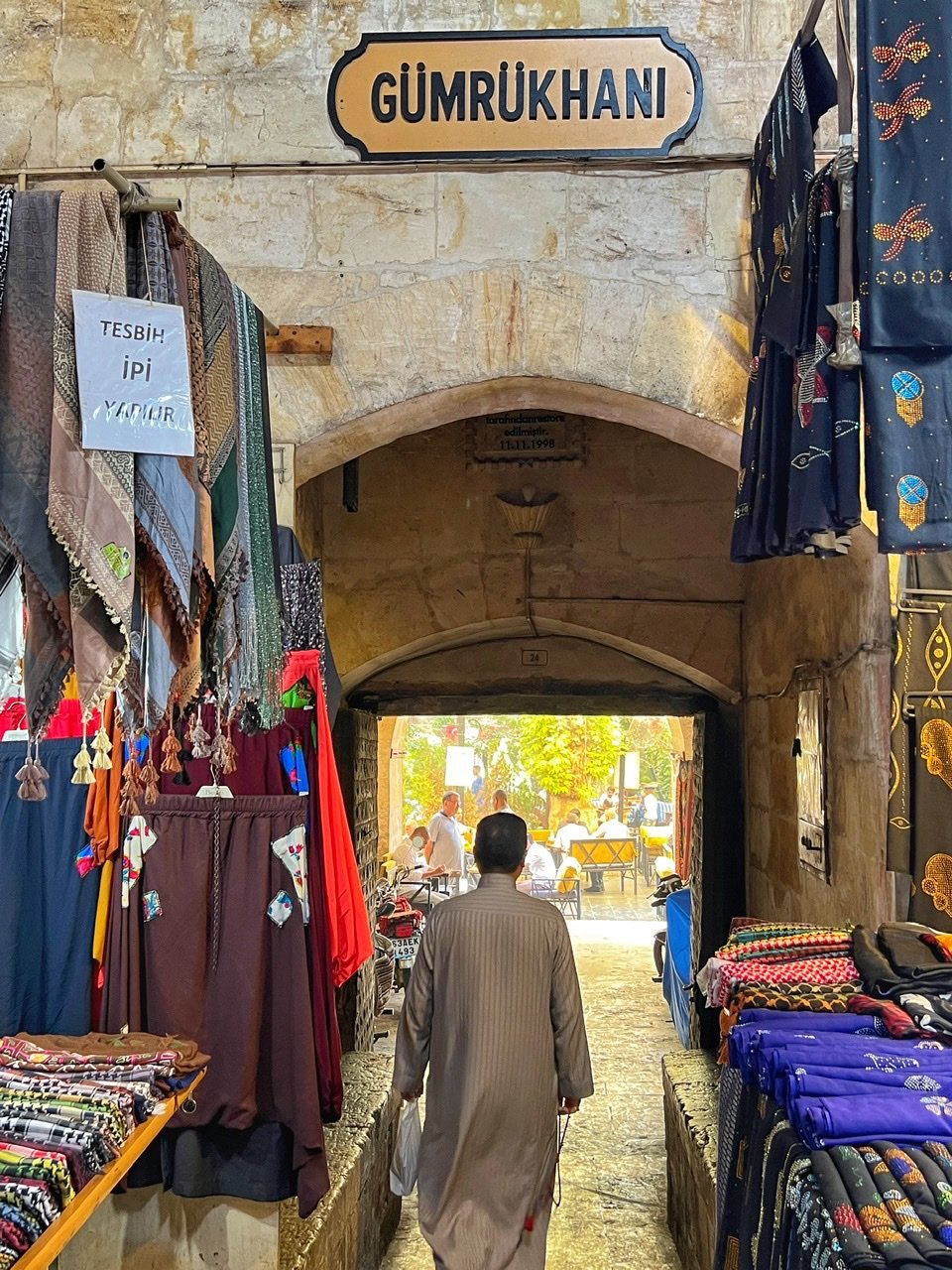
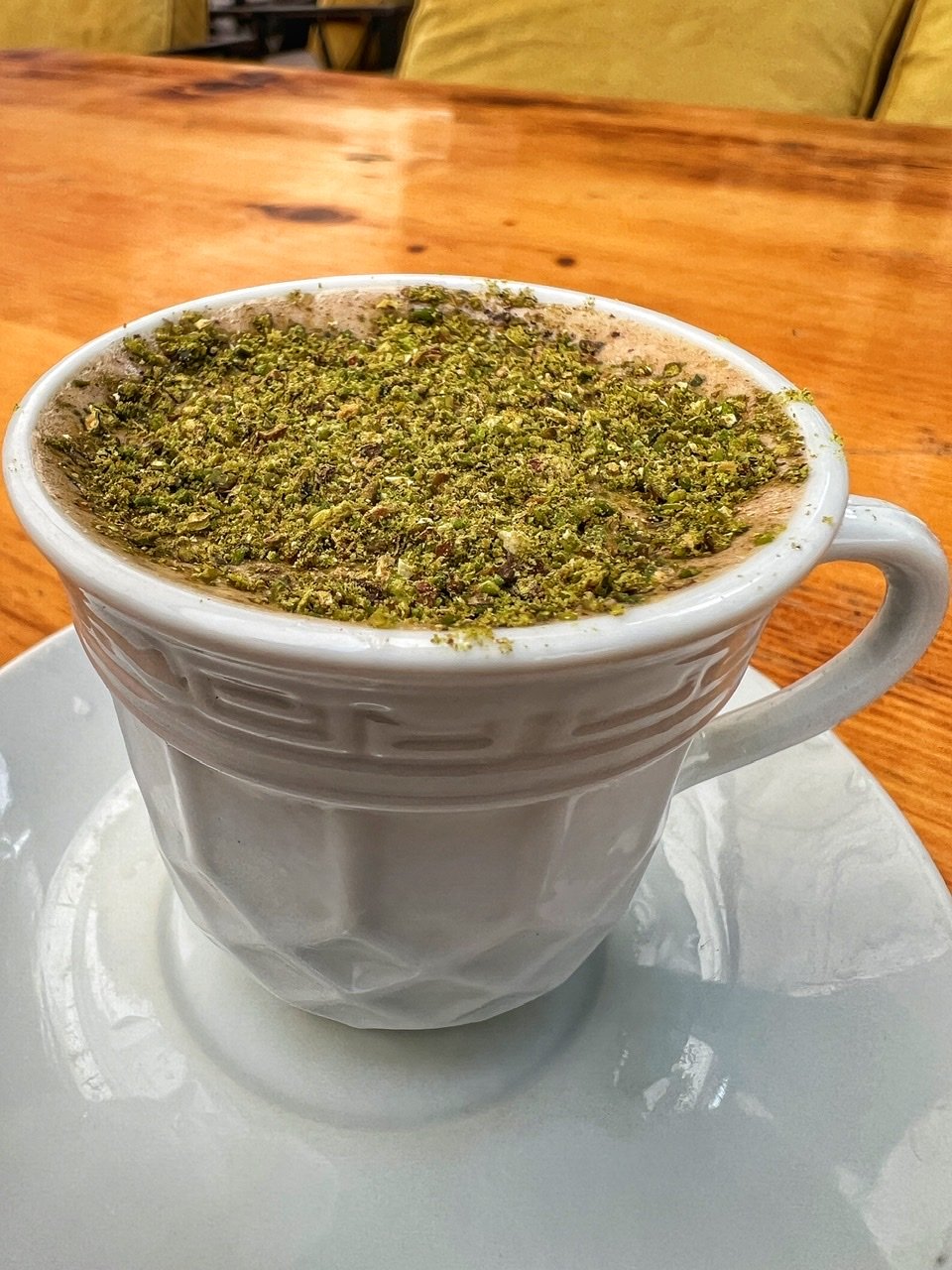
Heading into Gumruk Hani, a giant open air courtyard and former inn and cafe packed with locals. But this is not just an ordinary cafe. The Gumruk Hani was a caravanserai stop on the Silk Road dating from the 16th Century. It’s a popular place to have a Pistachio Coffee also known as Kurdish or Menengic coffee. This non-leaded traditional hot beverage is actually not coffee at all but made of ground roasted pistachio tree seeds as the main ingredient and topped with regular pistachios. It’s delicious and costs 15 Liras or about $.80.
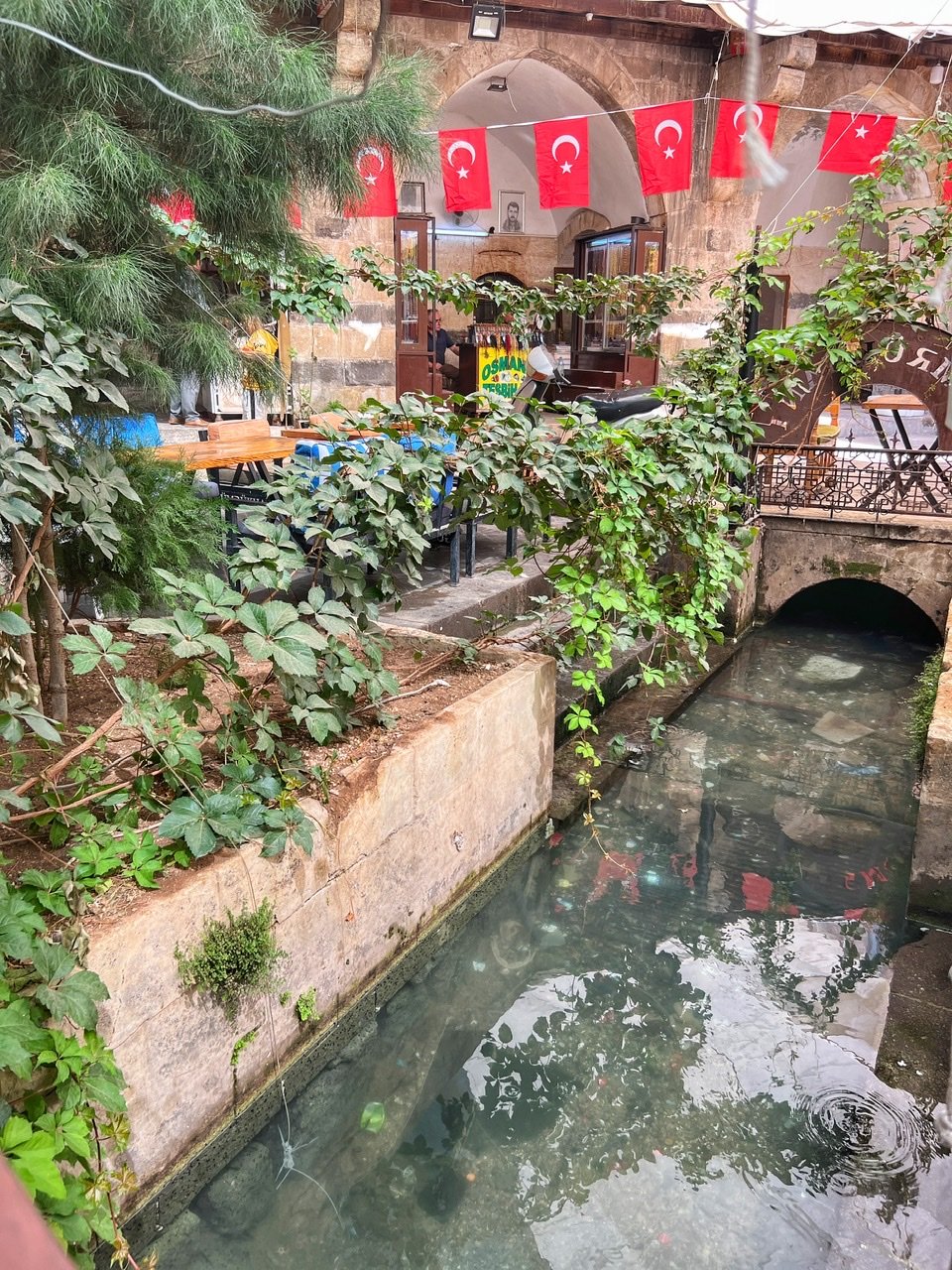
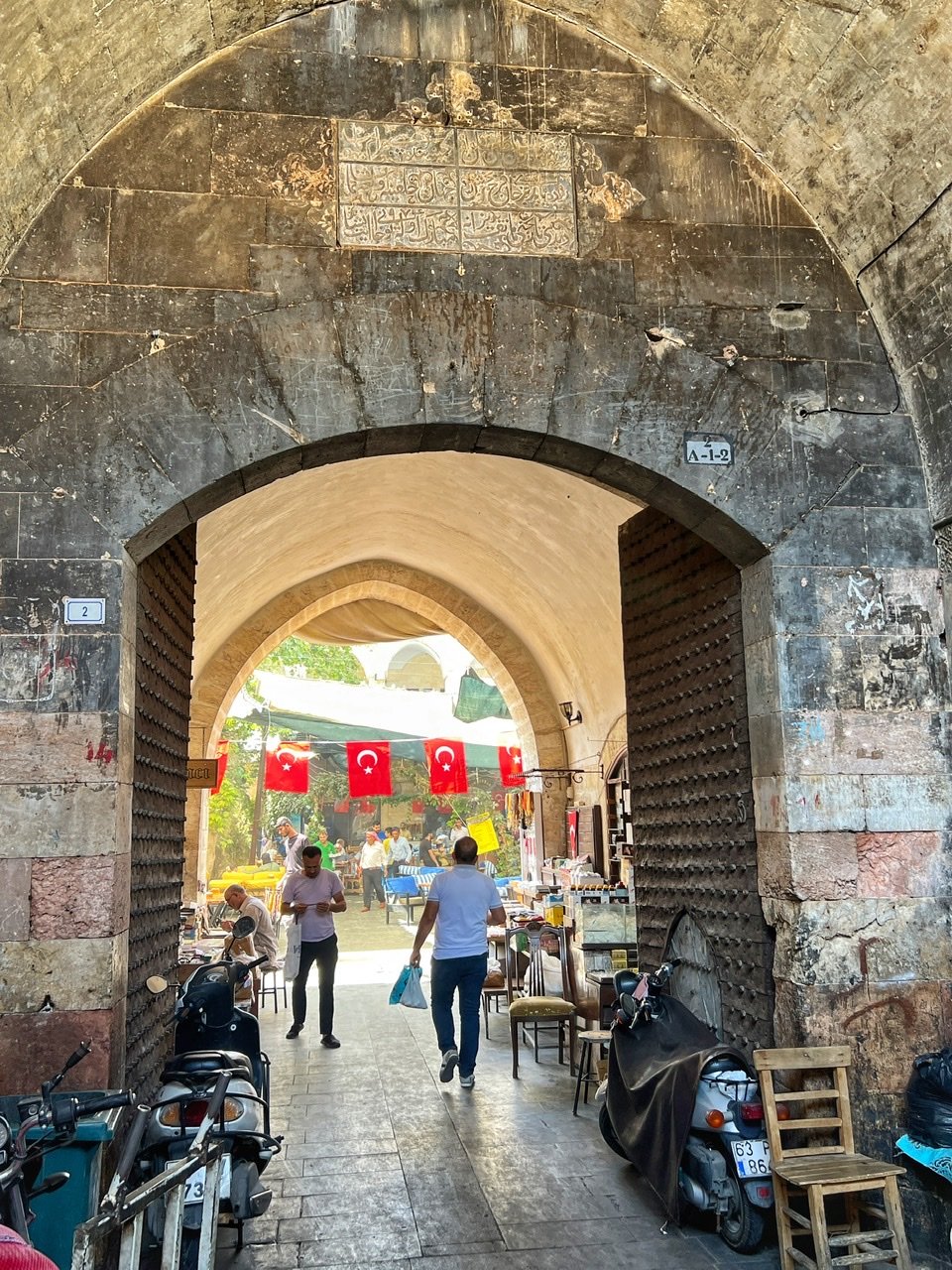

A small creek runs through Gumruk Hani. We’d like to believe this was for the horses to enjoy! Waiters were buzzing around everywhere, almost all of them carrying cups of pistachio or regular Turkish coffee or tea. A very unique experience.
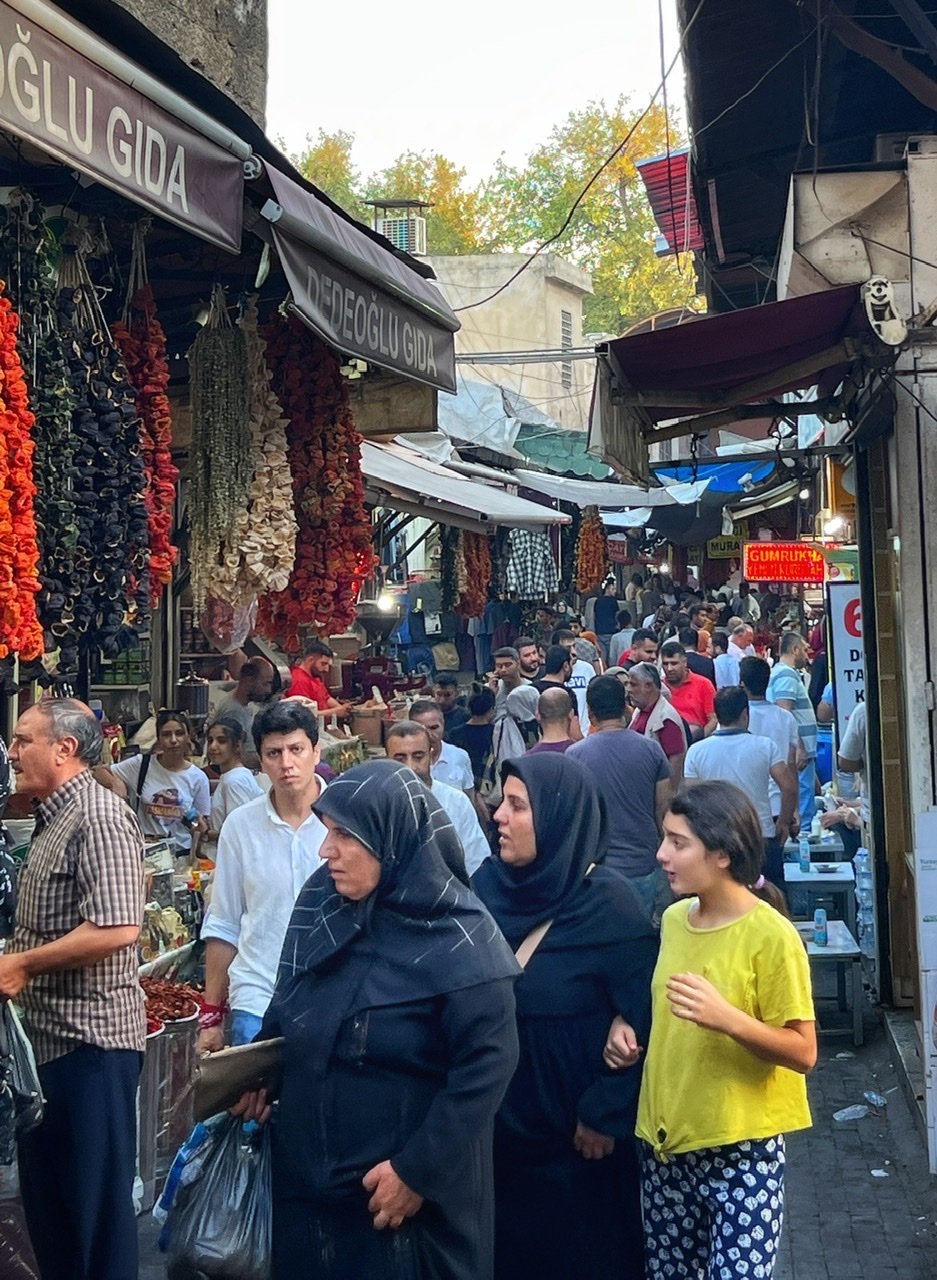
The buzzing commercial passages of Urfa leading into the souk where locals hang out and shop for groceries, spices, clothes, jewelry, and even furniture. Although we bought fruit with ease, the yogurt we purchased had random bits of paper in it for our typical yogurt dinner. It took us about 24 additional hours to find an actual grocery store that promised a bit more quality control! ?
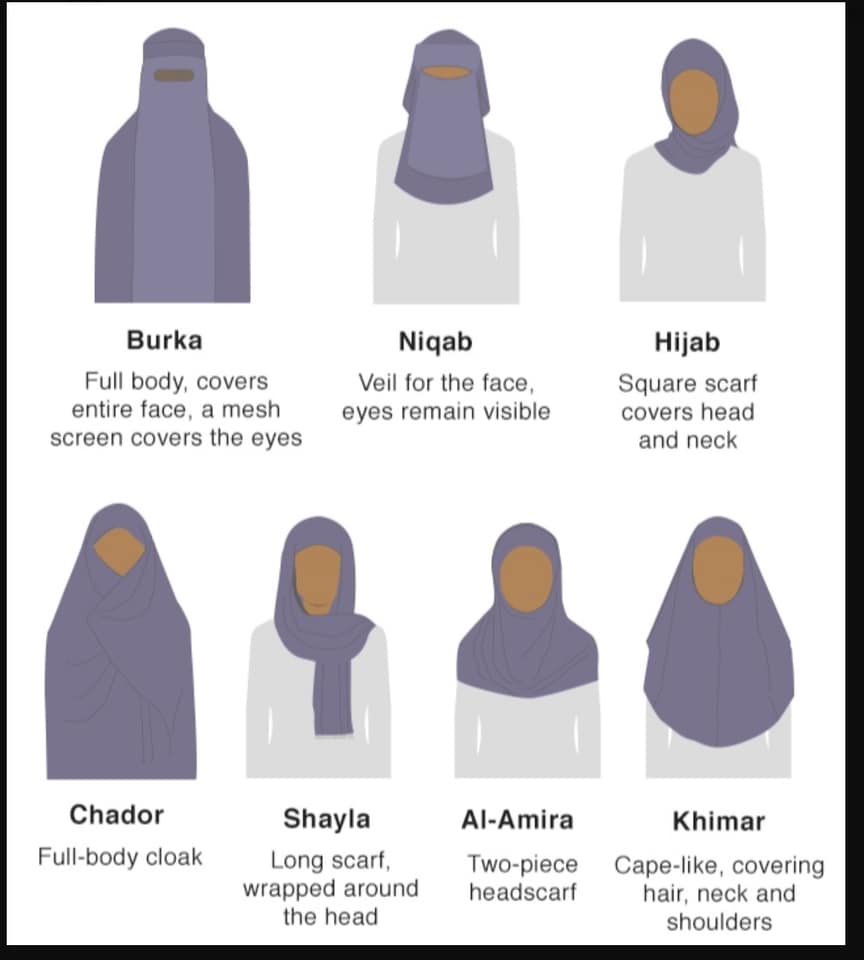
Because it’s a pilgrimage city, we presume, we saw many ladies in full niqab dressings in Urfa, which was practically unseen in previous parts of Türkiye. Of course, we did not take photos of them as it’s very disrespectful, but we did take a moment to review the various types of Islamic dress.
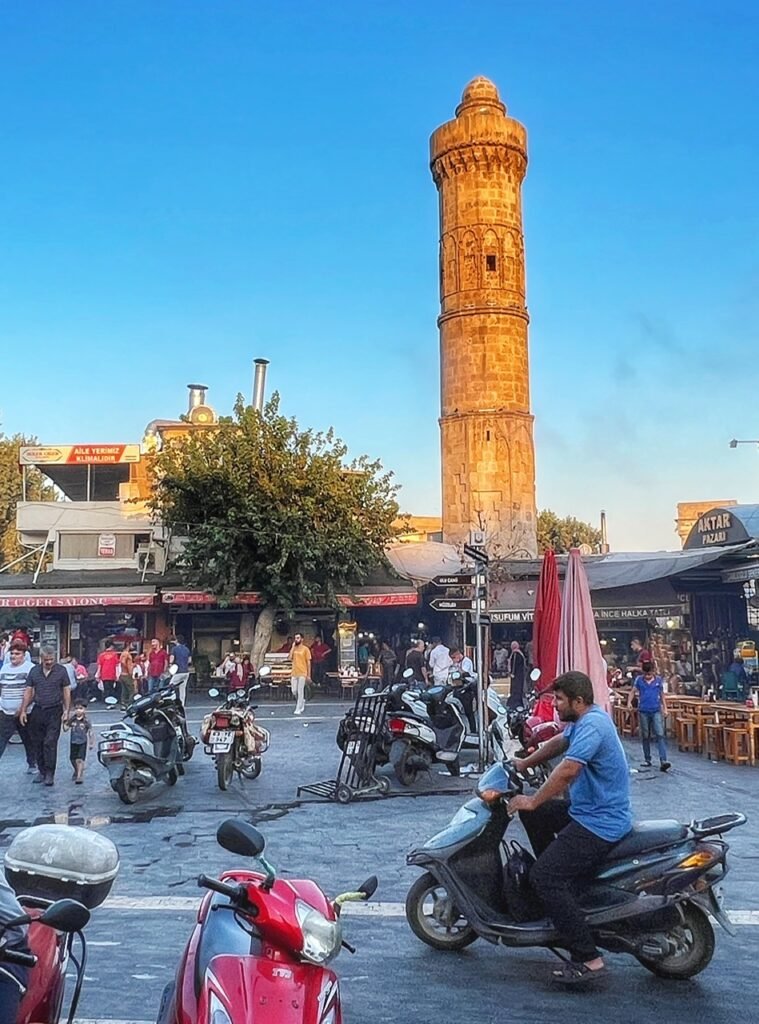
At the entrance to the souk. One of the most heartbreaking things to see in Urfa was the abundance of anguished-looking refugees…presumably Syrian and often shoeless children, grasping with outstretched paws for money. Although we handed some children fruit, we always make it a point not to give money to kids. There were also groups of women in niqabs sitting in clusters on the streets, although they never met your gaze or begged. However, one of the most heartfelt moments was when Greg gave a man pushing his legless son in a wheelchair 20 Liras (basically a $1). His whole face lit up and when we passed him on the street the next day, he gave us a spirited and smiley high five. Wish we could do more….
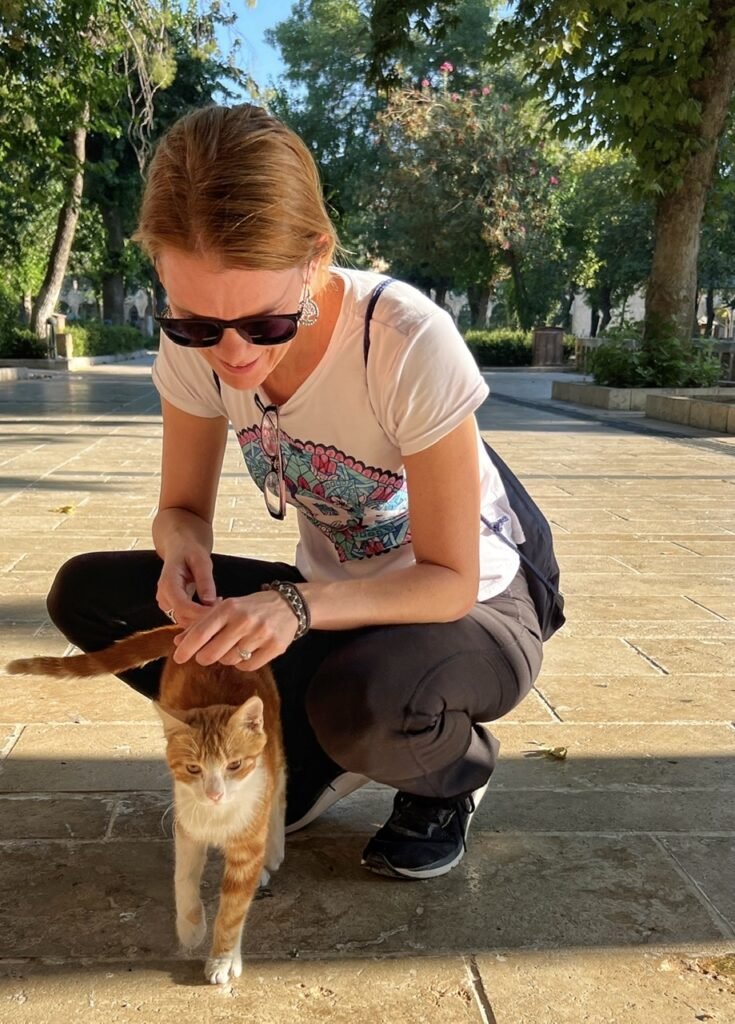
And of course, we’re still making a point to visit with the local kedis.
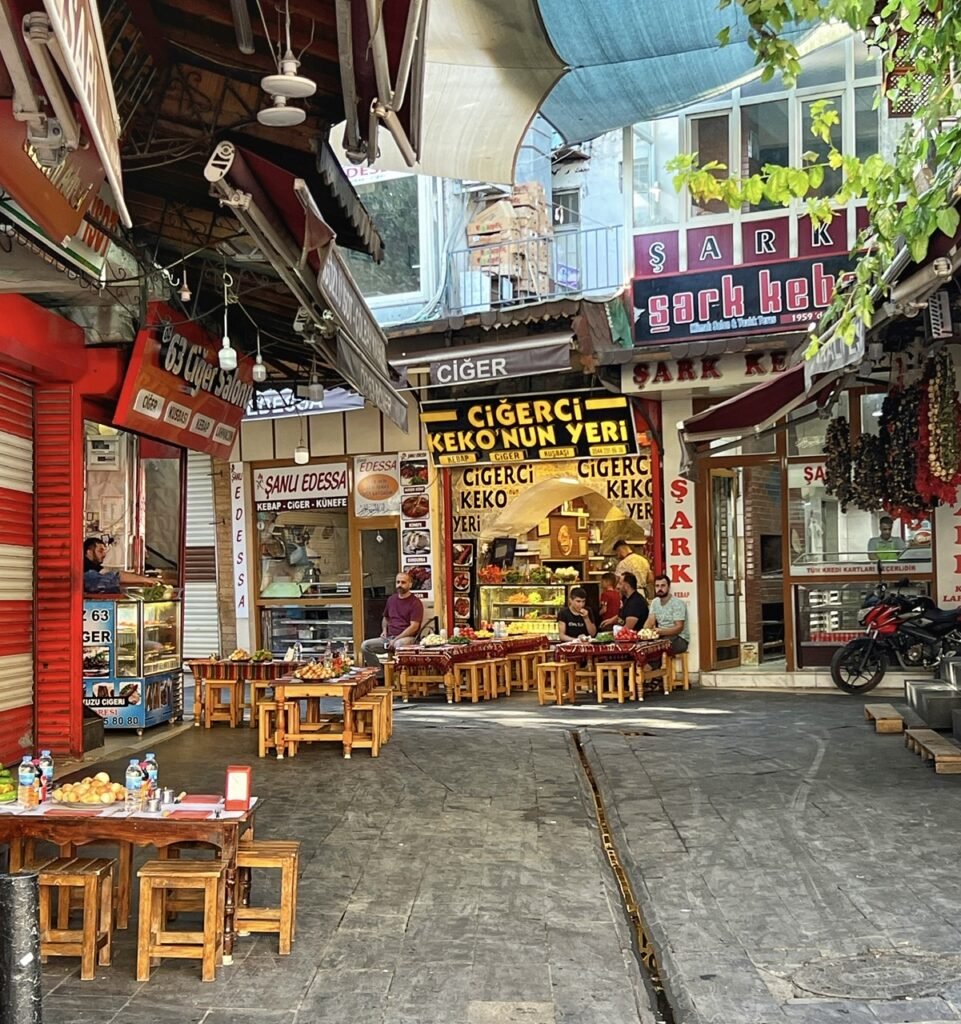
A street leading into the souk early in the morning.
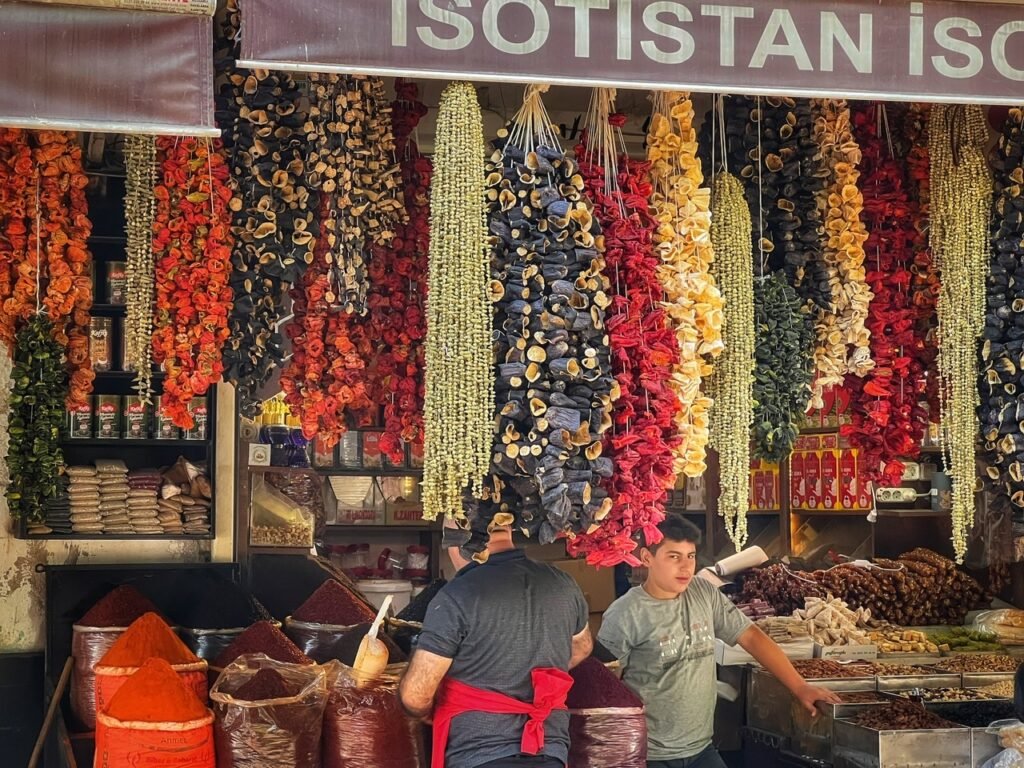
Dried flowers and other bits of nature which will soon be ground for herbs and spices. And yes, we got a big ‘ol evil eye for taking that photo!

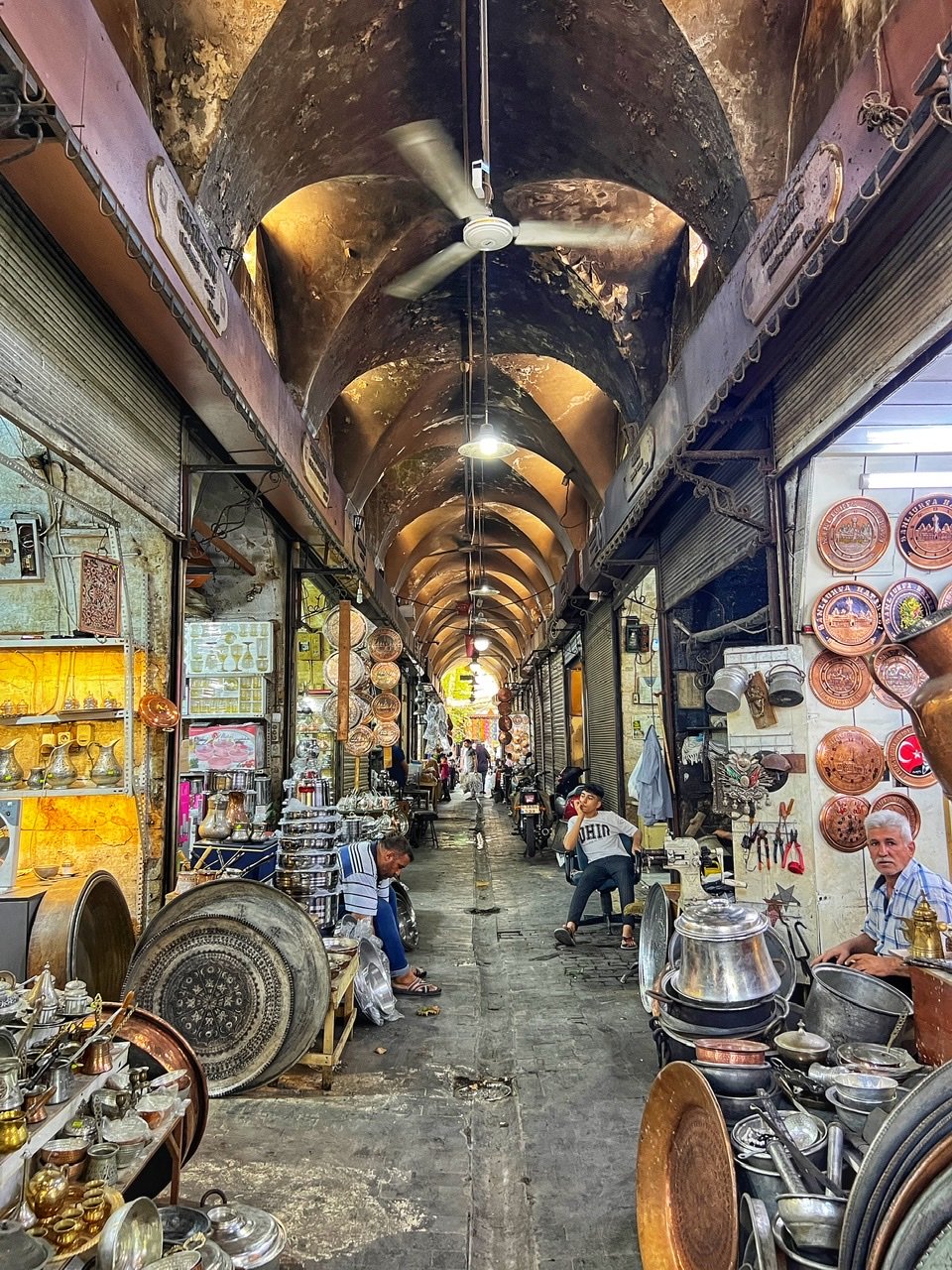
We loved observing daily life inside the souk dating from at least as early as the 1400’s.
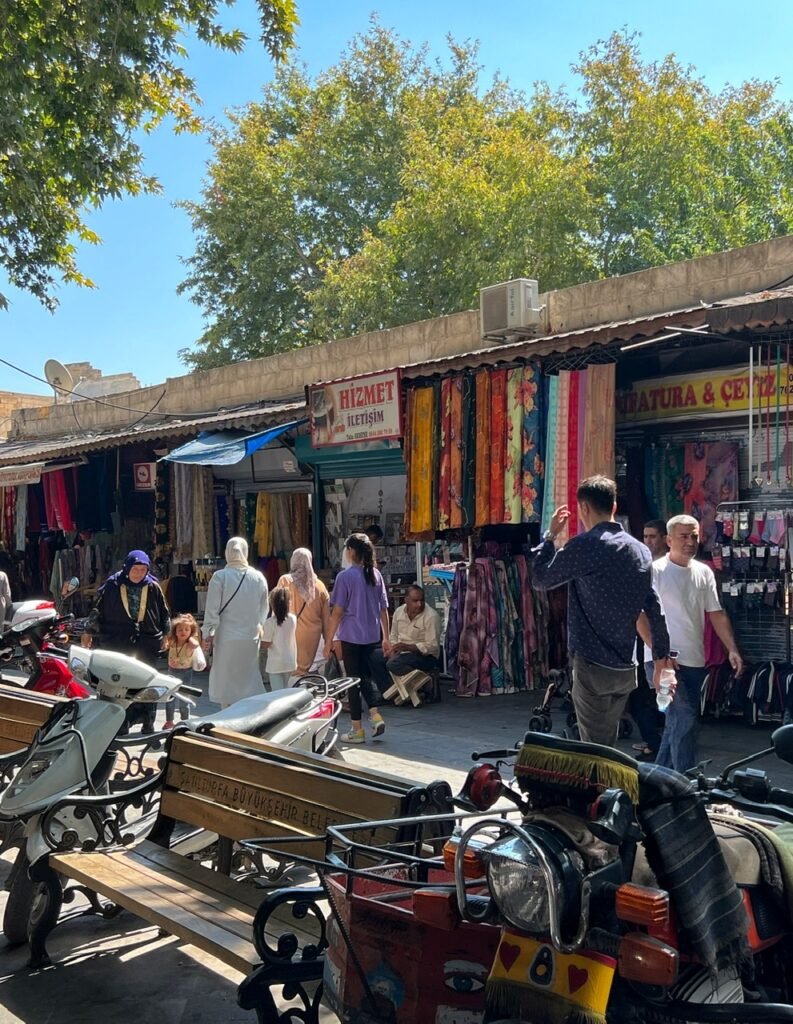
The atmosphere is lively and the place colorful.

When we were walking through the souk, this man said hello. Mandy asked him his name (in Turkish), prepared to do the full intro exchange, and he said his name was Imam. Since we know that “imam” likely was not a name, but a worship leader of a mosque for Sunni Muslims, we politely obliged his request to take a photo with him, especially when he showed us a picture of himself and President Erdoğan. His friend motioned for us to sit down, which we did, but then had us stand up and sit down in different positions a few more times. It was a very awkward exchange and rather than letting him What’s App the photo, we just took a photo of his photo. ?
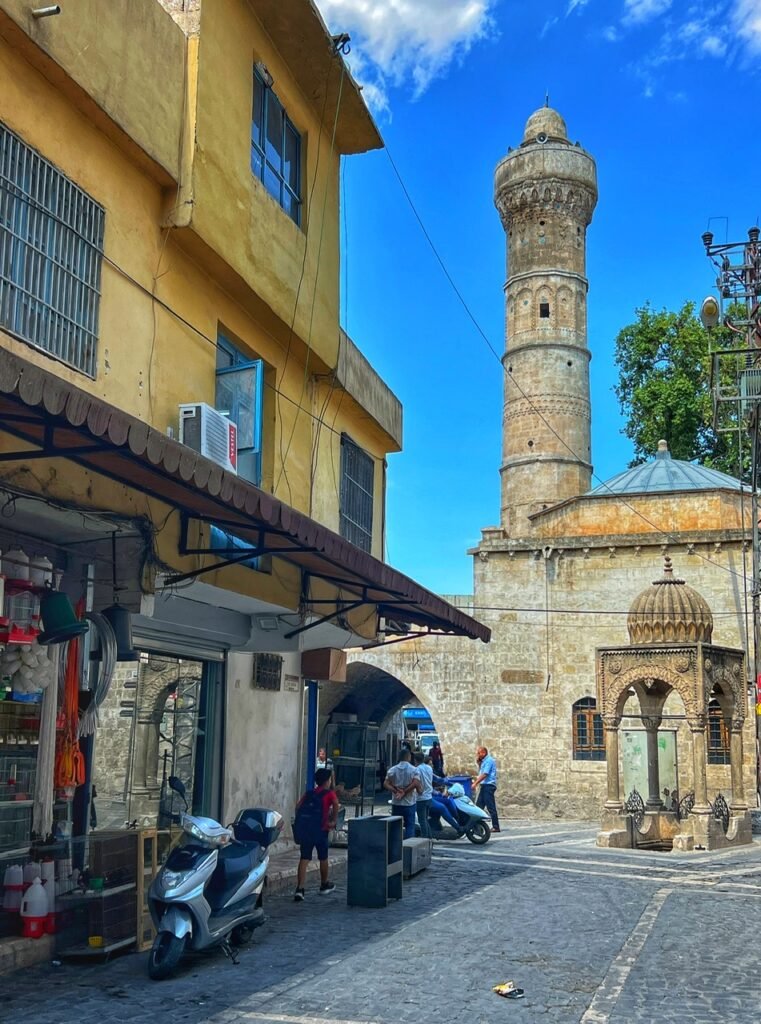
A simple less crowded street scene in Urfa.
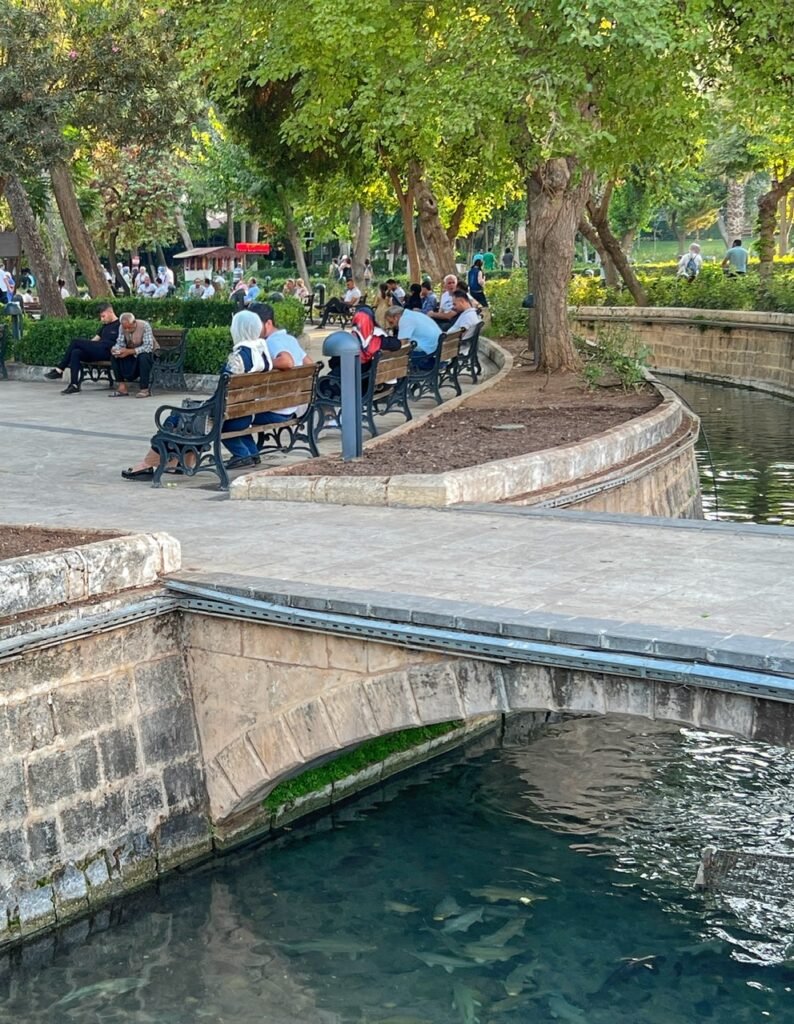
One of the absolute treasures of Urfa is Golbasi Park, which is where many of the historic Abraham sites are and is dotted with mosques and lakes. It’s also wonderful for people watching, fish feeding and strolling. We observed others and only linked hands when it seemed totally acceptable.
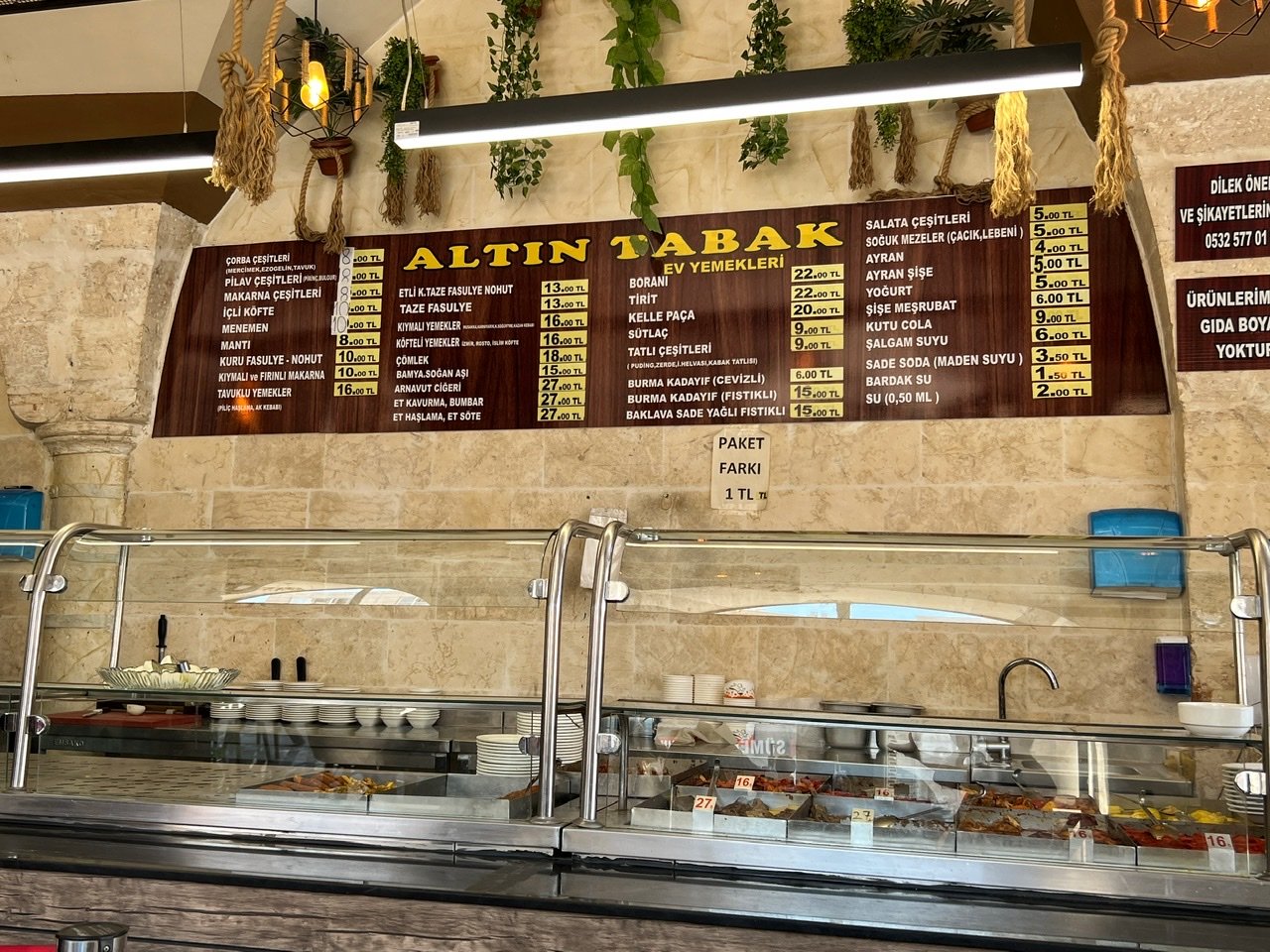

The menu of a lokanta restaurant with traditional Turkish food. 18 Liras=$1. We stuffed ourselves one meal a day regularly and rarely spent more than $8-9 for both of us. Dinner was about $1 (yogurt and fixings) and breakfast free making our daily food allowance around $10. Also, a giant piece of baklava that Greg ate all by himself! “It’s $1! Get your own!” he told his wife. ???♀️
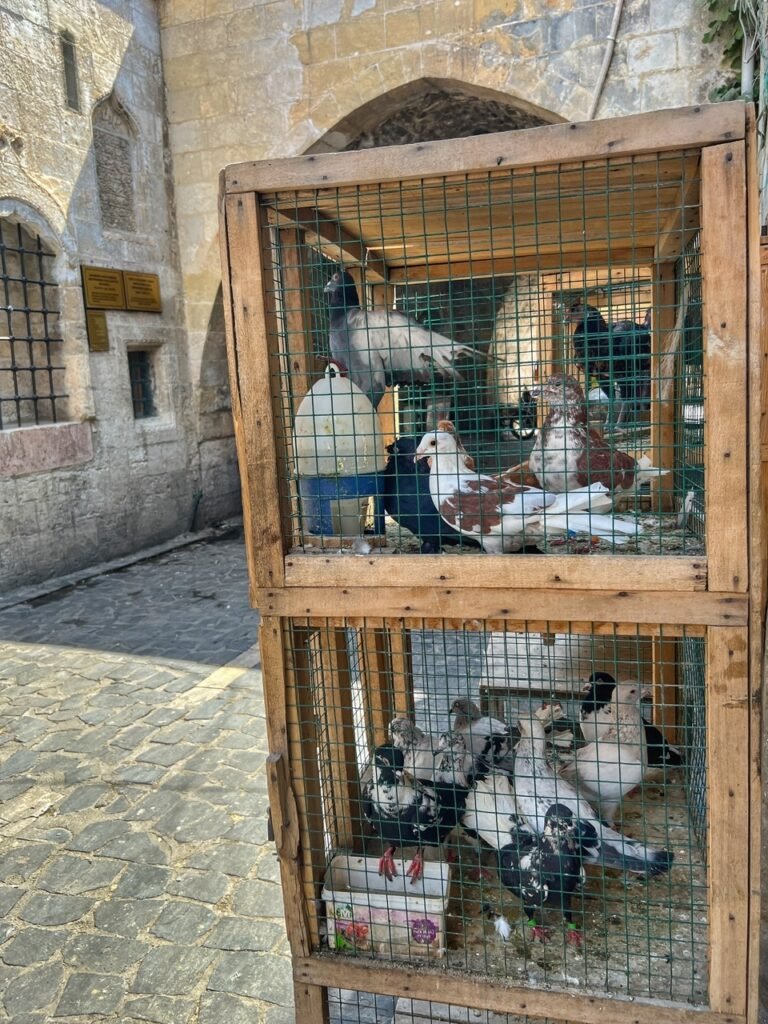
Ok. So the pigeons…they are everywhere in Türkiye and not just the annoying bird/rat variety you see endlessly pecking at every cigarette butt and gum wrapper in every city around the world. These pigeons are more civilized, evidently.
For example, many of them are in cages, which at first glance may seem cruel but apparently, Turkey’s ancient practice of pet pigeon raising began seeing new life during the quarantine. During this time, when people were not allowed outside, people lived vicariously through their birds who were able to spread their wings and flee the coop everyday, yet always returned “home.”
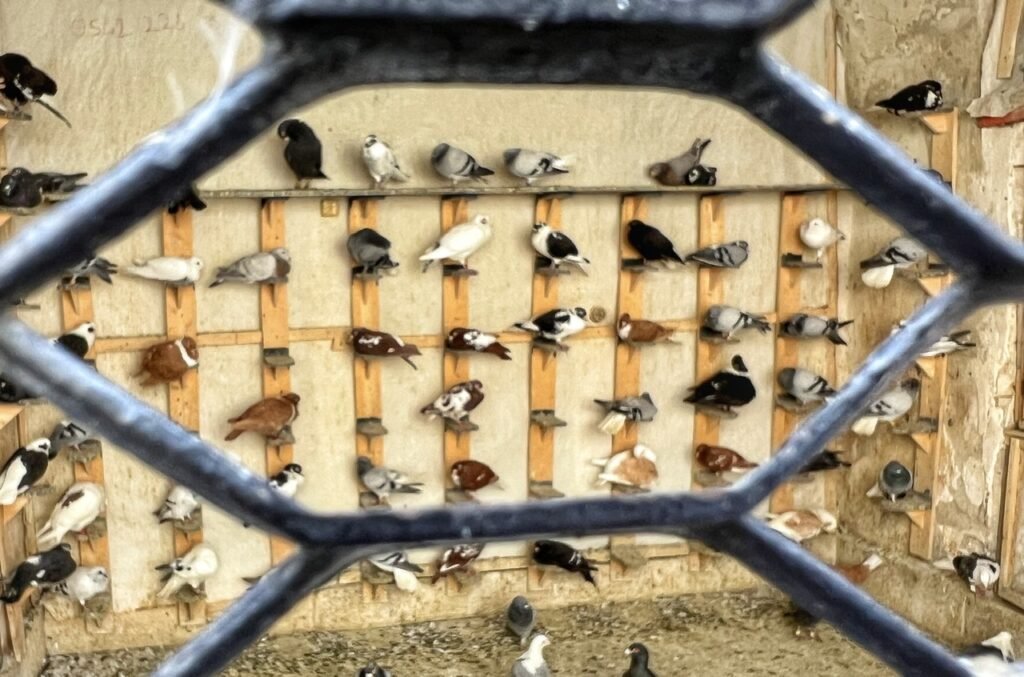
In fact, these birds seem quite happy cooing and sitting on their designated perches. According to theworld.org, “pigeons are thought to be one of the world’s earliest domesticated animals, raised for food and fertilizer as early as 10,000 BC. They appear in Mesopotamian cuneiform tablets and Egyptian hieroglyphics. Pigeons helped early shipbuilders navigate the Mediterranean Sea, and carried messages in wartime across the Central Asian steppes. Notably, pigeons always fly back to the place they consider home.”
Hmmm…who knew?!
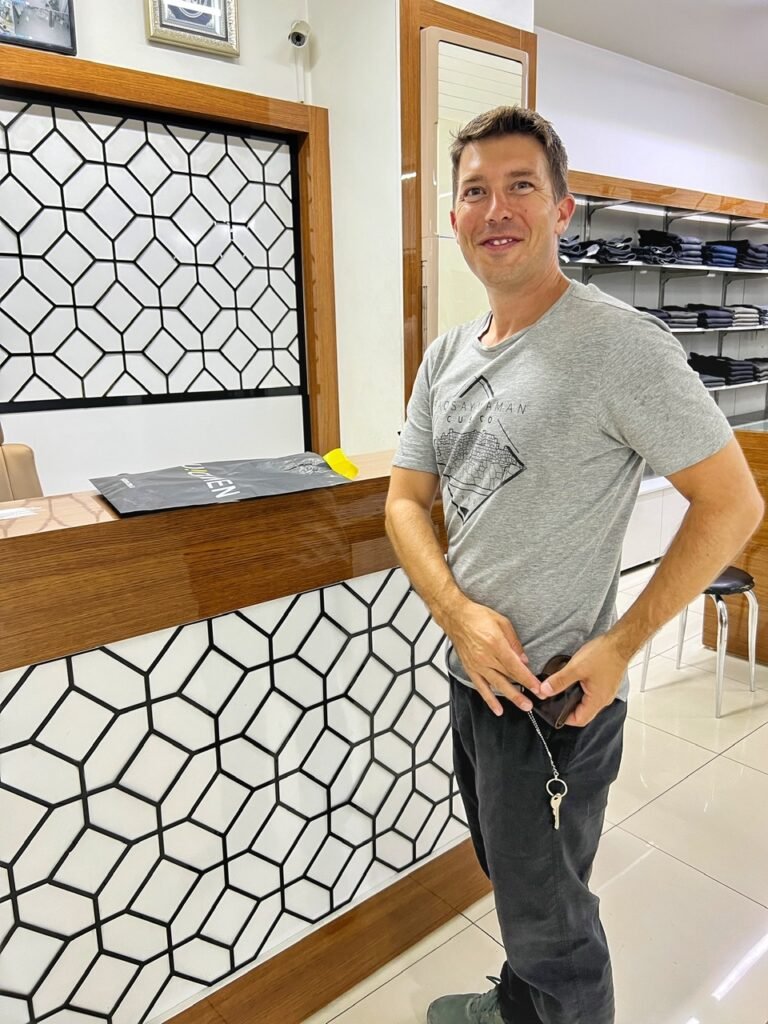
Another thing we did while living in Urfa was some clothes shopping. Well, Greg did because the clothes here were a bit “frumpy” for Mandy’s taste. However, Greg had some interesting fitting room experiences. Namely, the fact that he’s supposedly an XL in Türkiye, not a Small or Medium! And no offense, but the Turks aren’t exactly the petite guy Thais or Cambodians where that made a little more sense!
(Side note: no, the sexy woman shirt which Greg sports did not come from Urfa, but the one in the bag he’s purchasing did!)
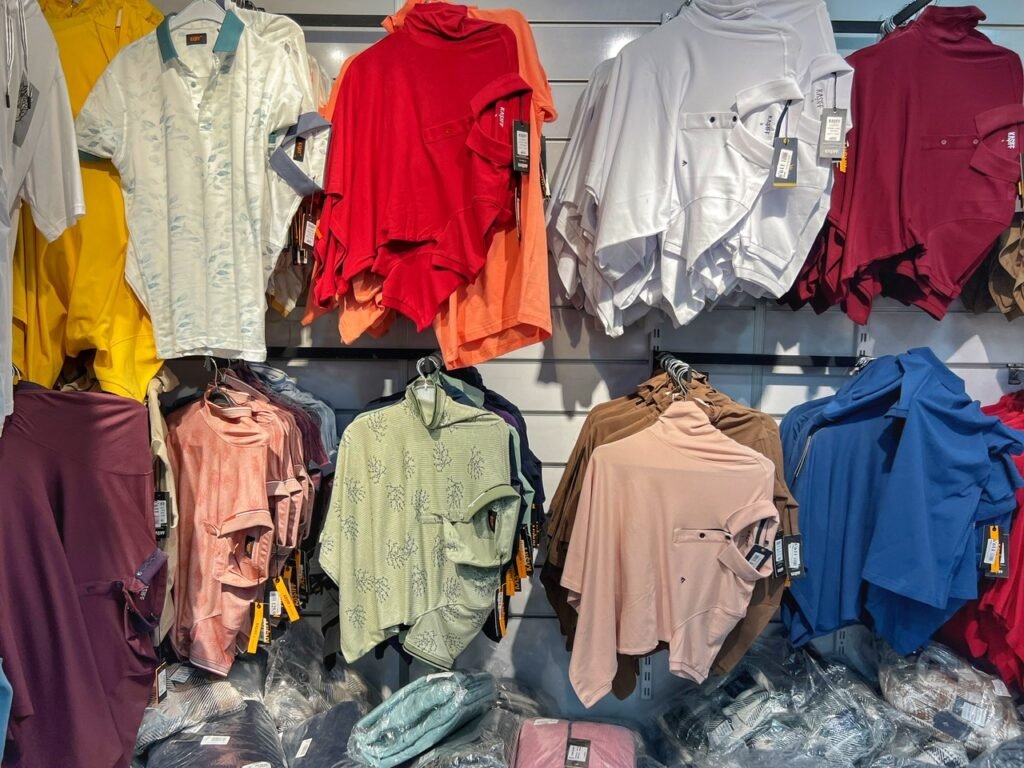
Another peculiarity. It seemed to be a retail trend to hang shirts sideways in Urfa. But uh…not sure that is working out. ?
One last shopping story…Mandy decided to walk into a shop that was selling sunglasses because you know… frumpy clothes…. It seemed, however, we had unknowingly wandered into a perfume shop. Immediately after asking where we were from, without asking, the shopkeeper hosed Greg with what appeared to be an old school pesticide applicator using two hands full of old school Brut Musk. Mandy couldn’t stop giggling at her husband who wasn’t overly thrilled with this imposition and also now smelled like…her father. She did stop laughing, however, when the shopkeeper then hosed her with a perfume that went back a couple generations even before. Gag. So much for wearing those clothes for a couple days without washing.?
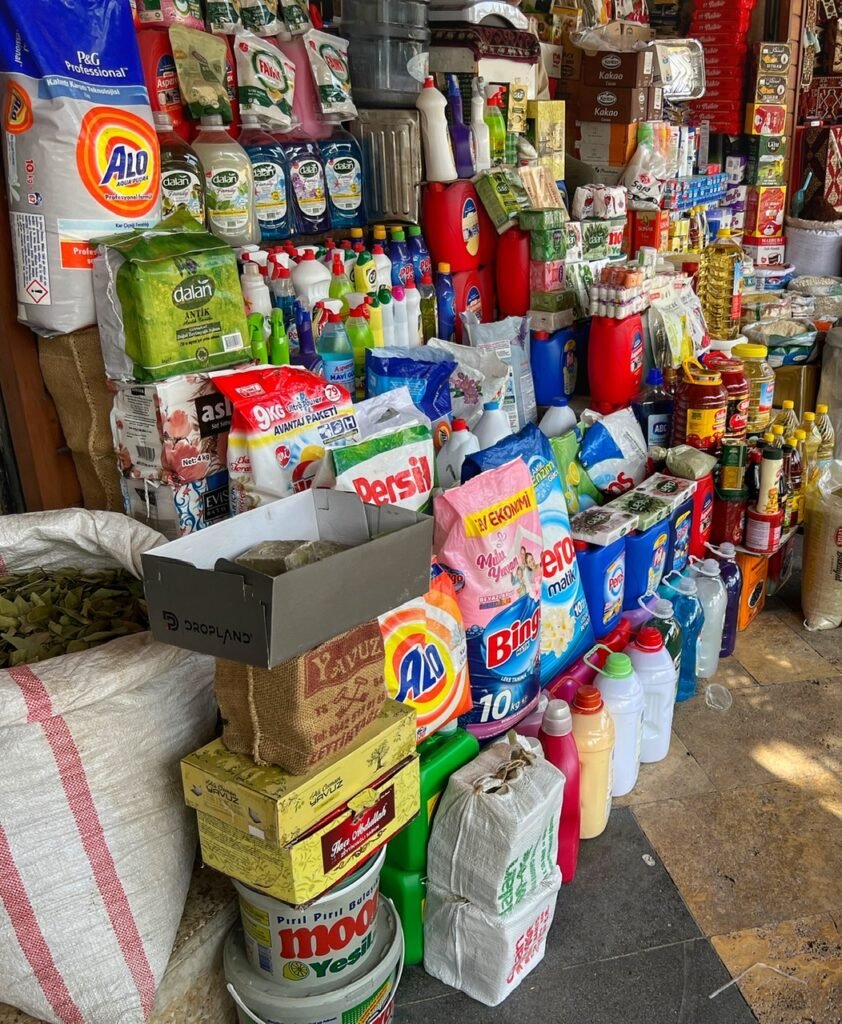
It’s a good thing we also were able to buy laundry detergent by the grams which we particularly appreciated! 200 grams was $.17!
Sanliurfa Archeological & Mosaic Museums
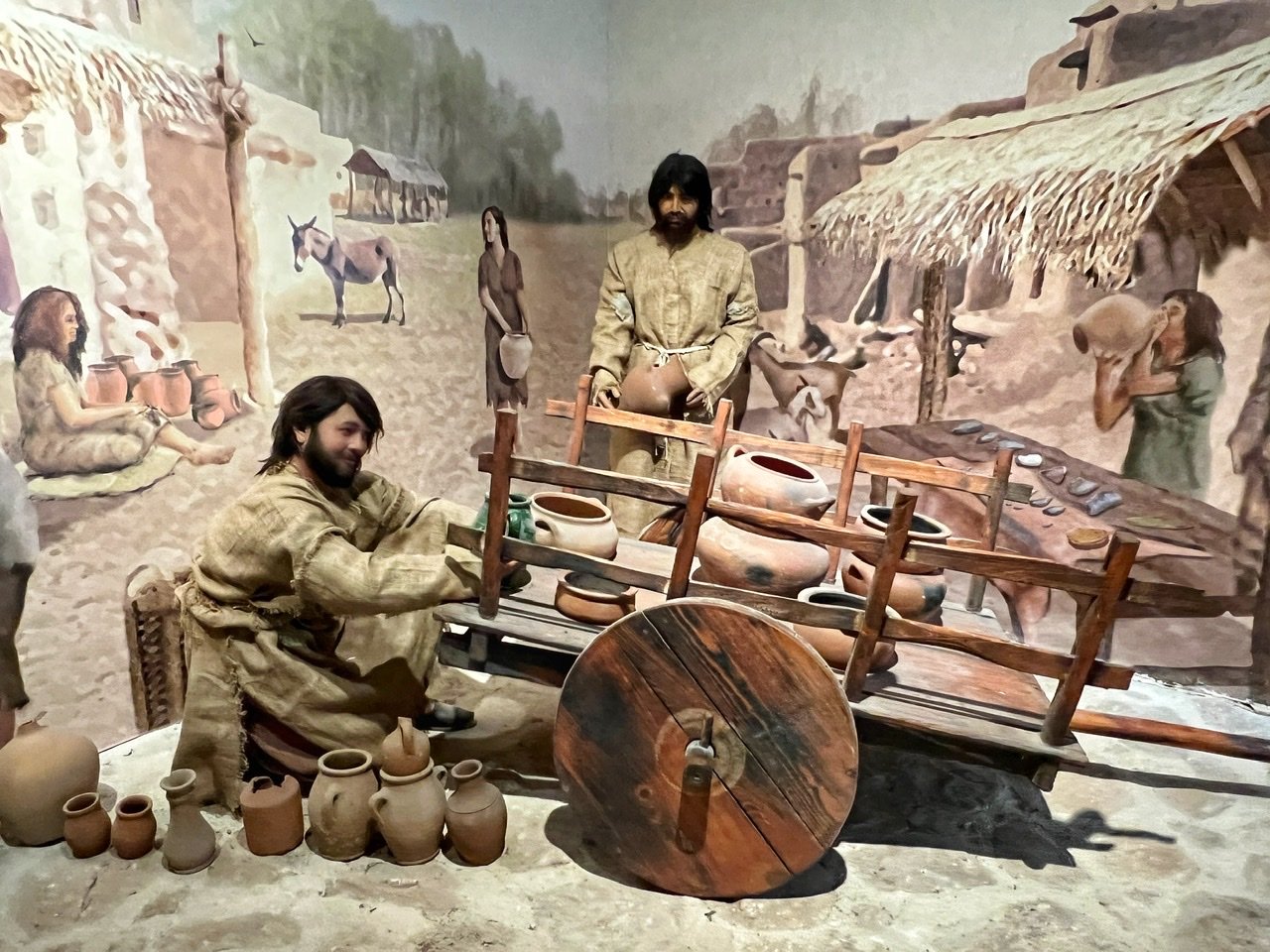
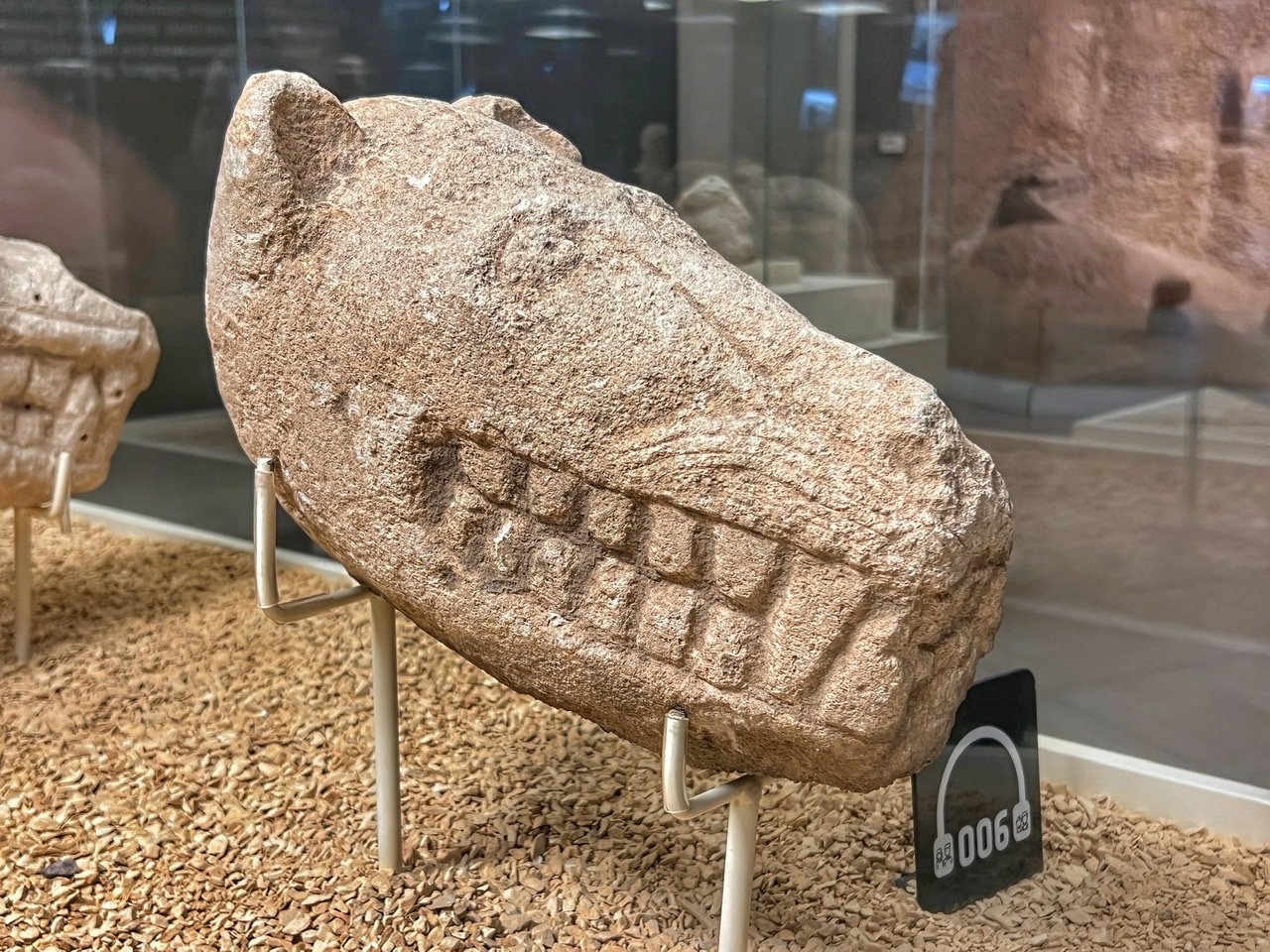
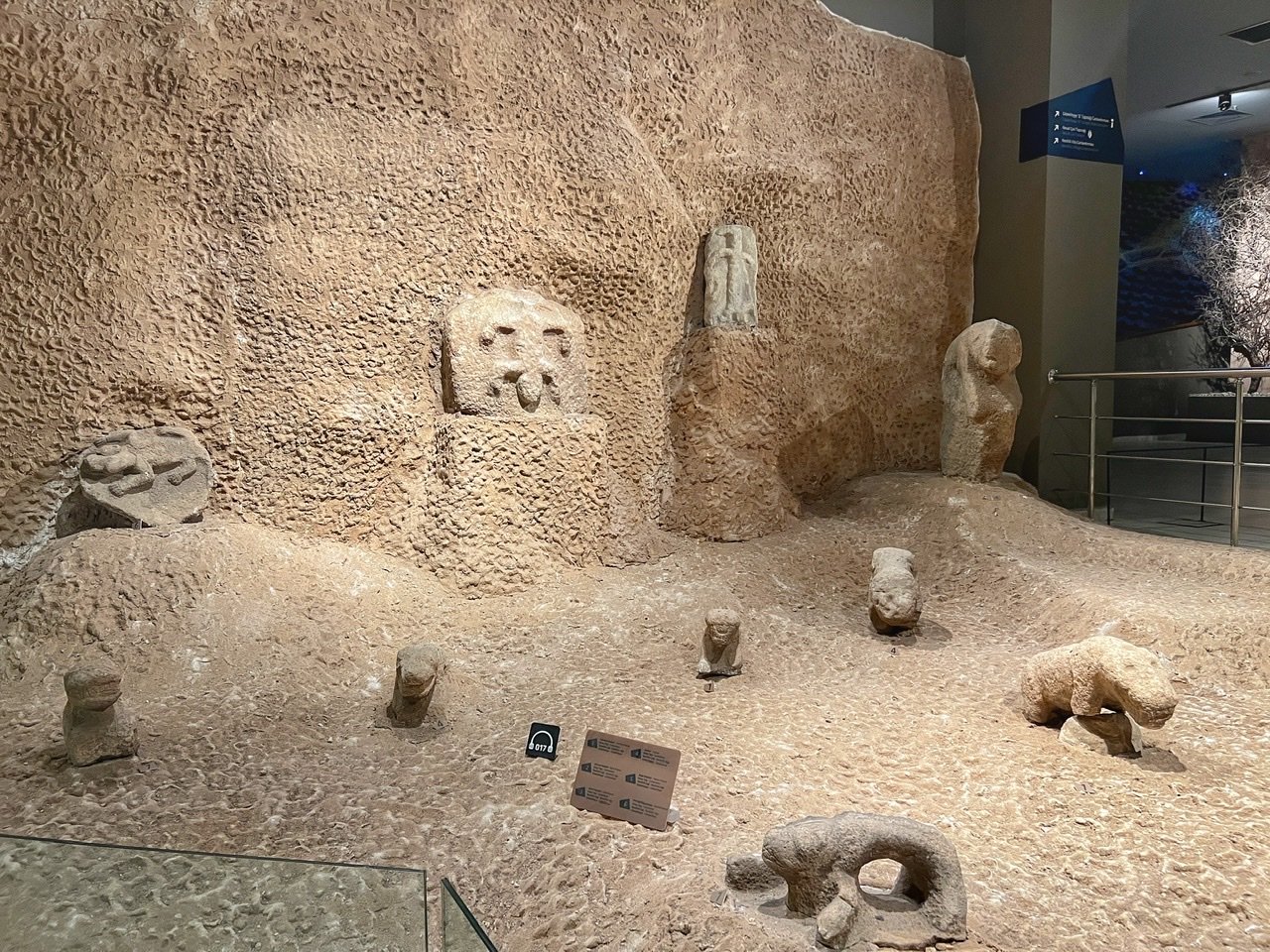


As we’ve mentioned, Şanlıurfa is one of the oldest inhabited regions on earth so it’s no surprise that treasure upon treasure has been found here. Therefore, an absolute must see in the city is the archeological and mosaic museums. The cost to enter both museums is 50 Liras or $2.25.

One very special treasure you may have seen depictions of before is the “Urfa Man.” This statue is the oldest full-size sculpture of a human being yet discovered. Dating to about 9,000 BC, it is an iconic piece for the city’s superb Archaeological Museum.
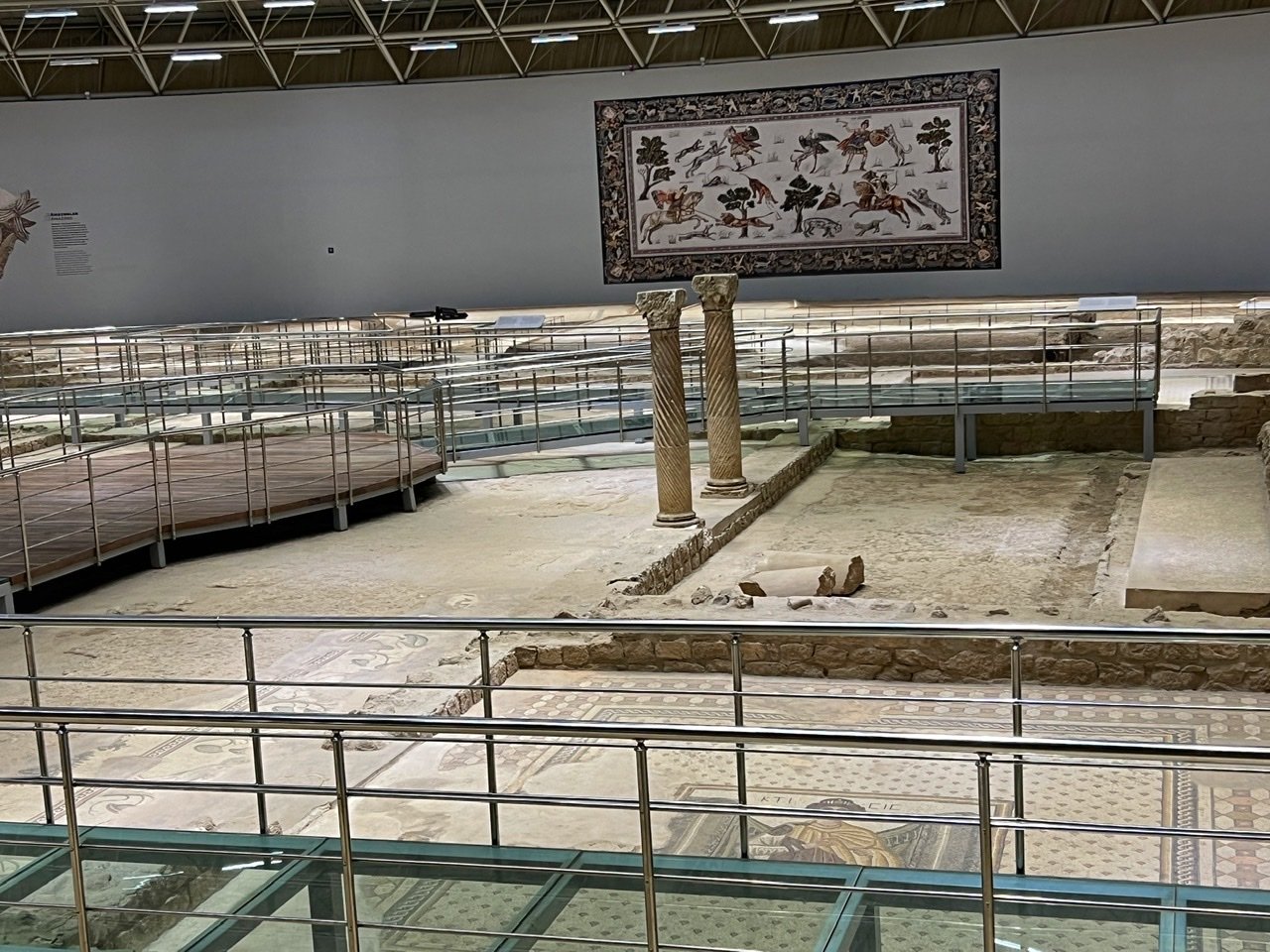
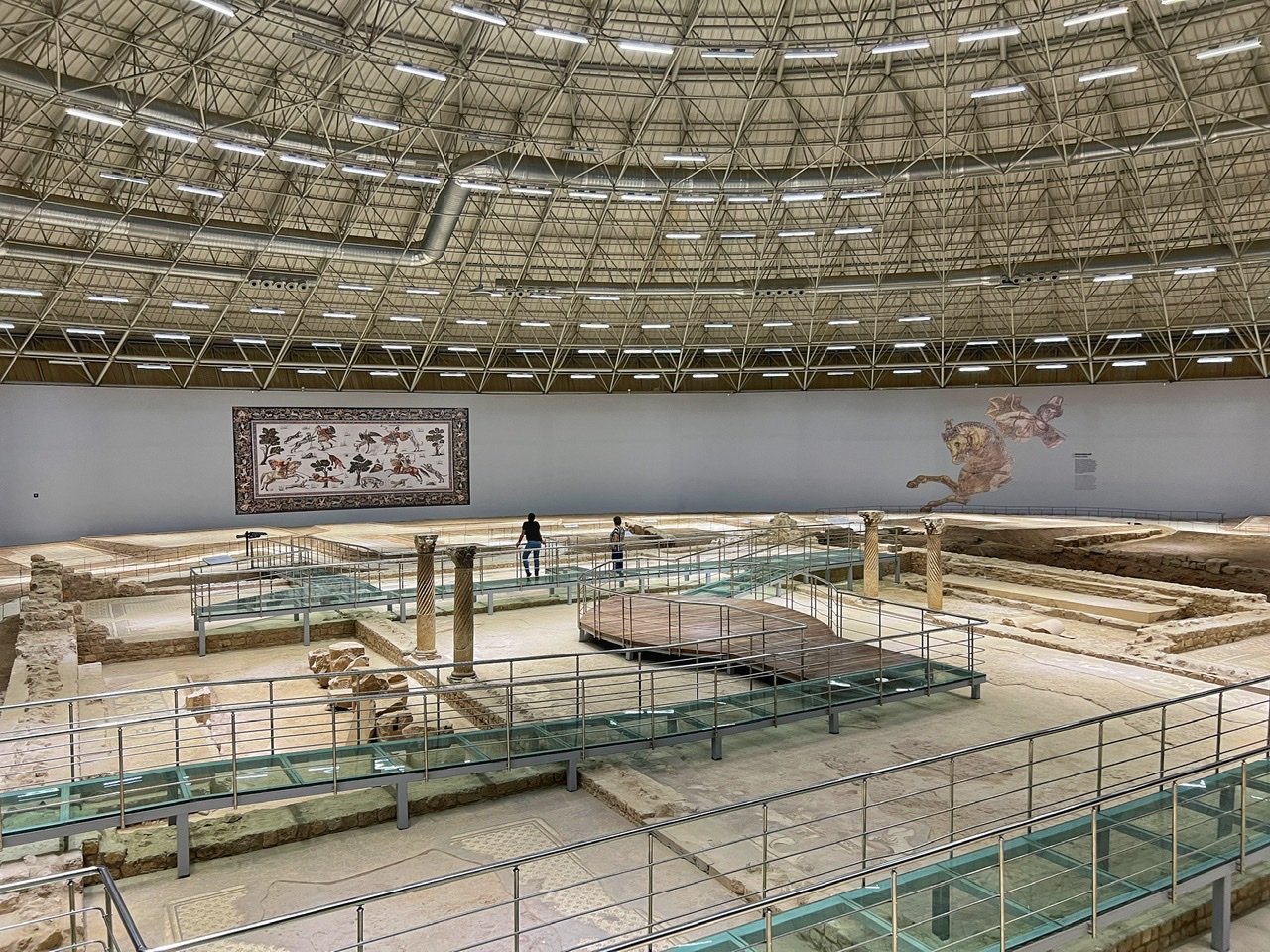
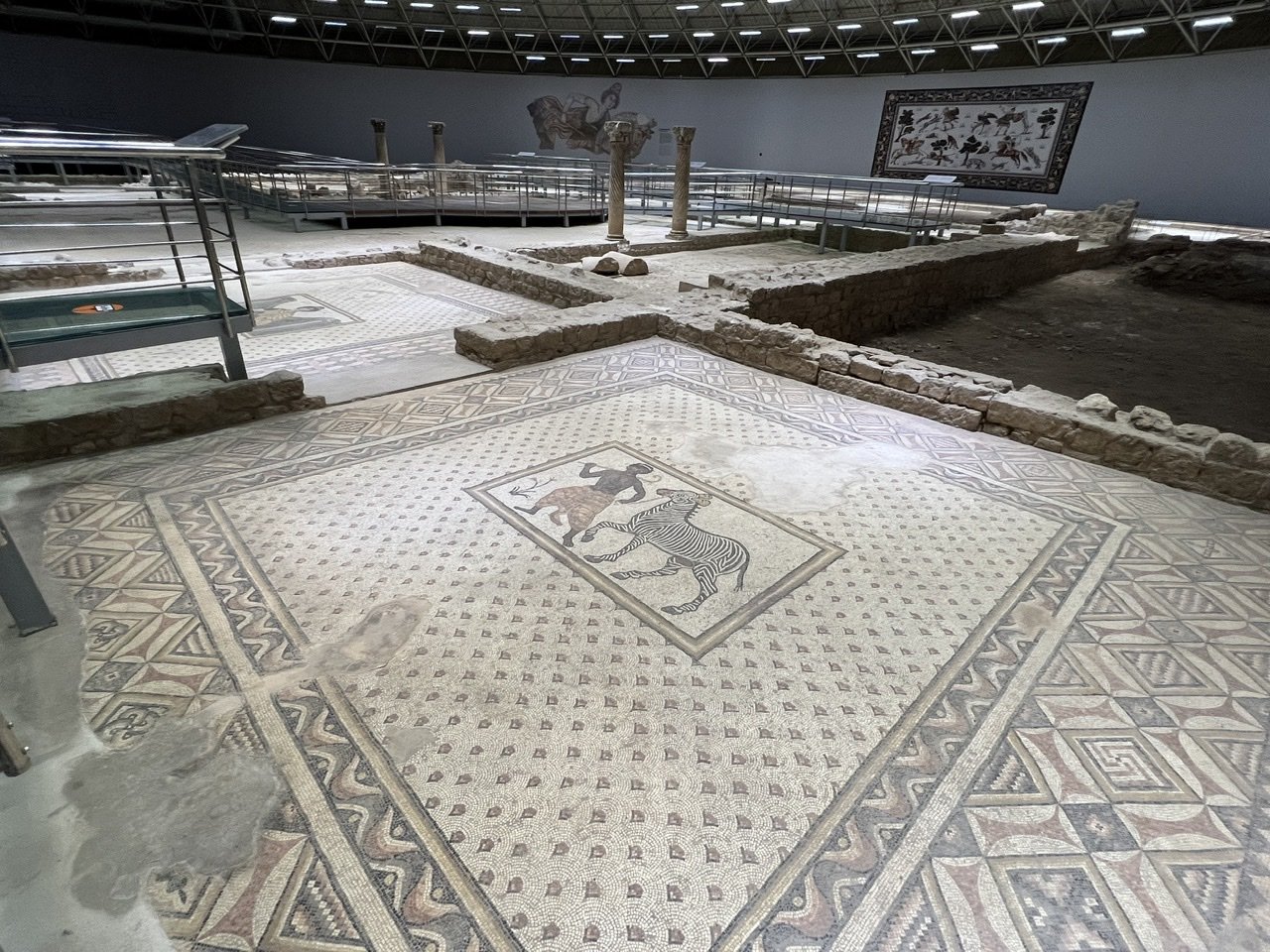
And then there’s the also included mosaic museum. Don’t skip it! Imagine being a city worker digging a parking lot and discovering layers upon layers of massive ancient mosaics on the ground underneath you, some from as early as the 3rd and 4th Century BC. This is exactly what happened in Sanliurfa in 2006. Rather than removing the mosaics for exhibition at the archeological museum, the mosaics were kept in place and the mosaic museum was built around them, even including original Greek columns. It opened in 2015.
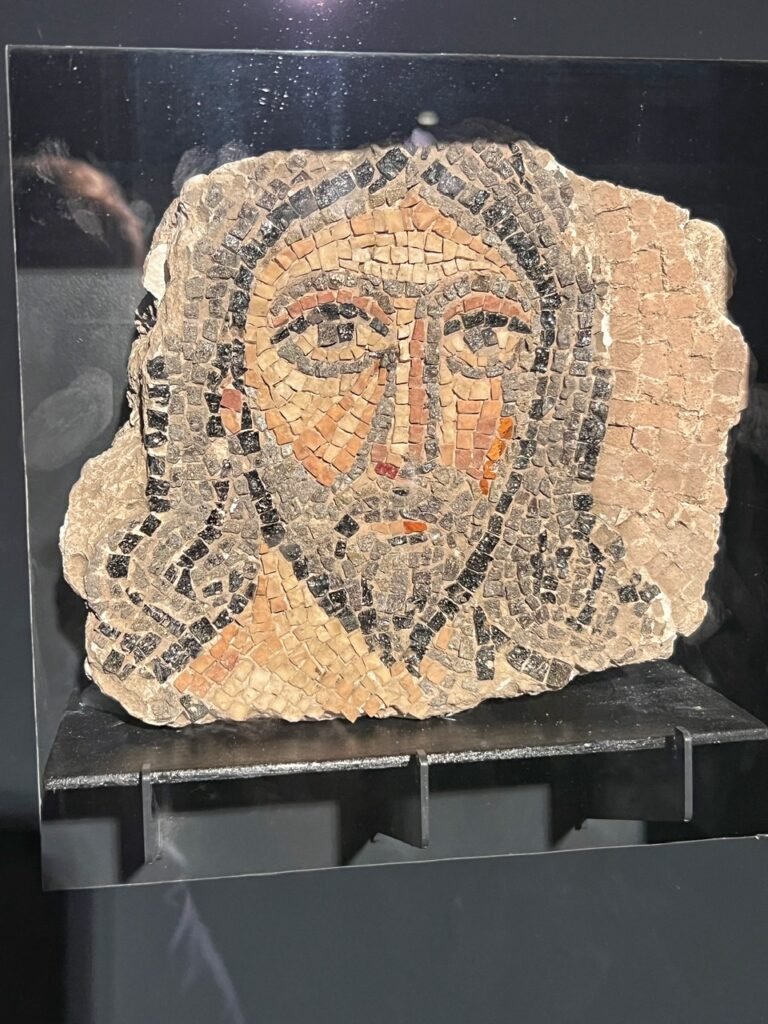
This Jesus mosaic, also in the museum, is quite rare and was found at a different location. Note…those eyes are definitely not blue.
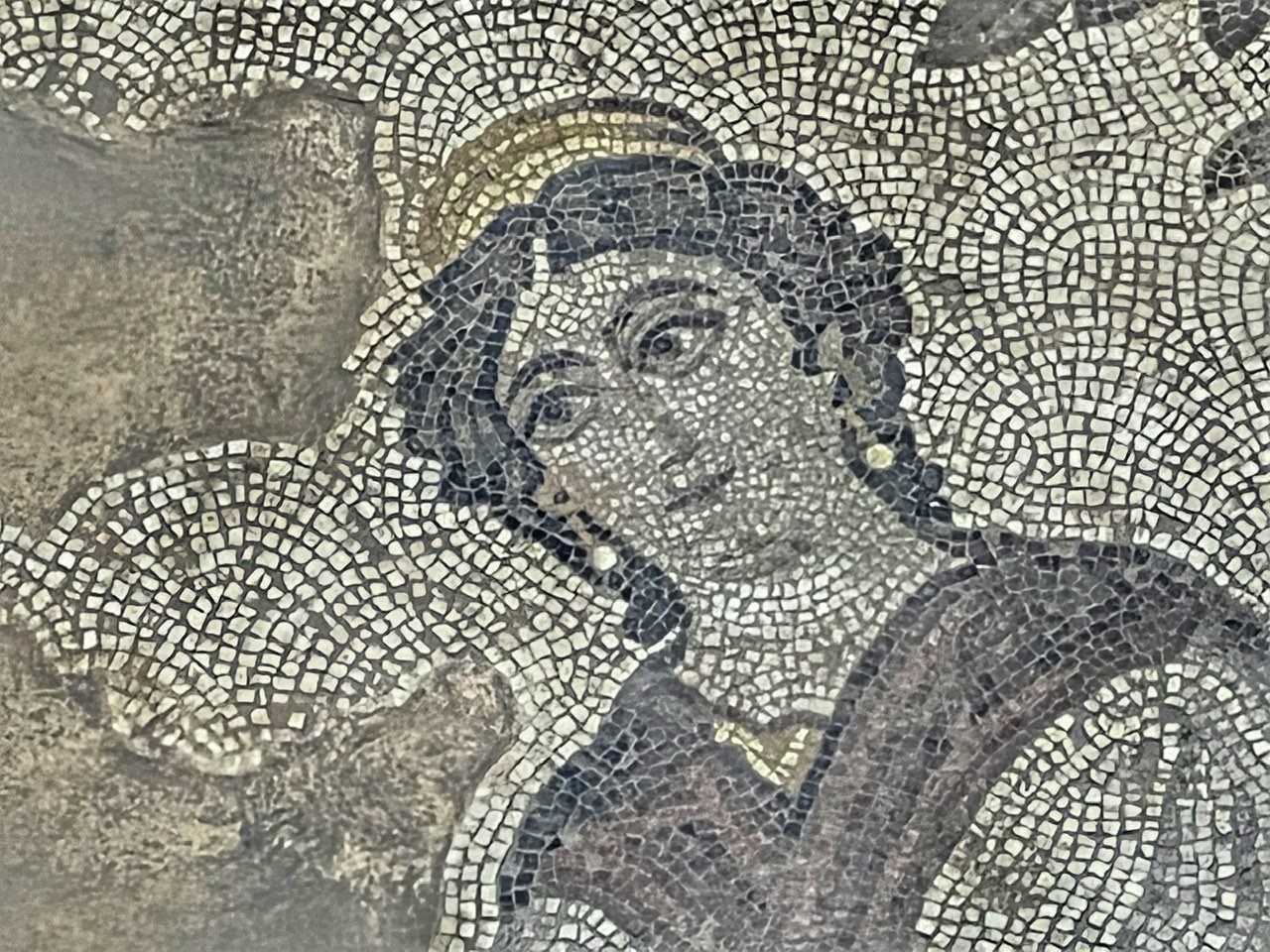

What is that woman doing to that baby!? Fortunately, one of our followers helped us figure it out. It’s likely Thetis dipping Achilles in a cauldron to give him immortality. Hey, can’t say the Greeks weren’t inventive.
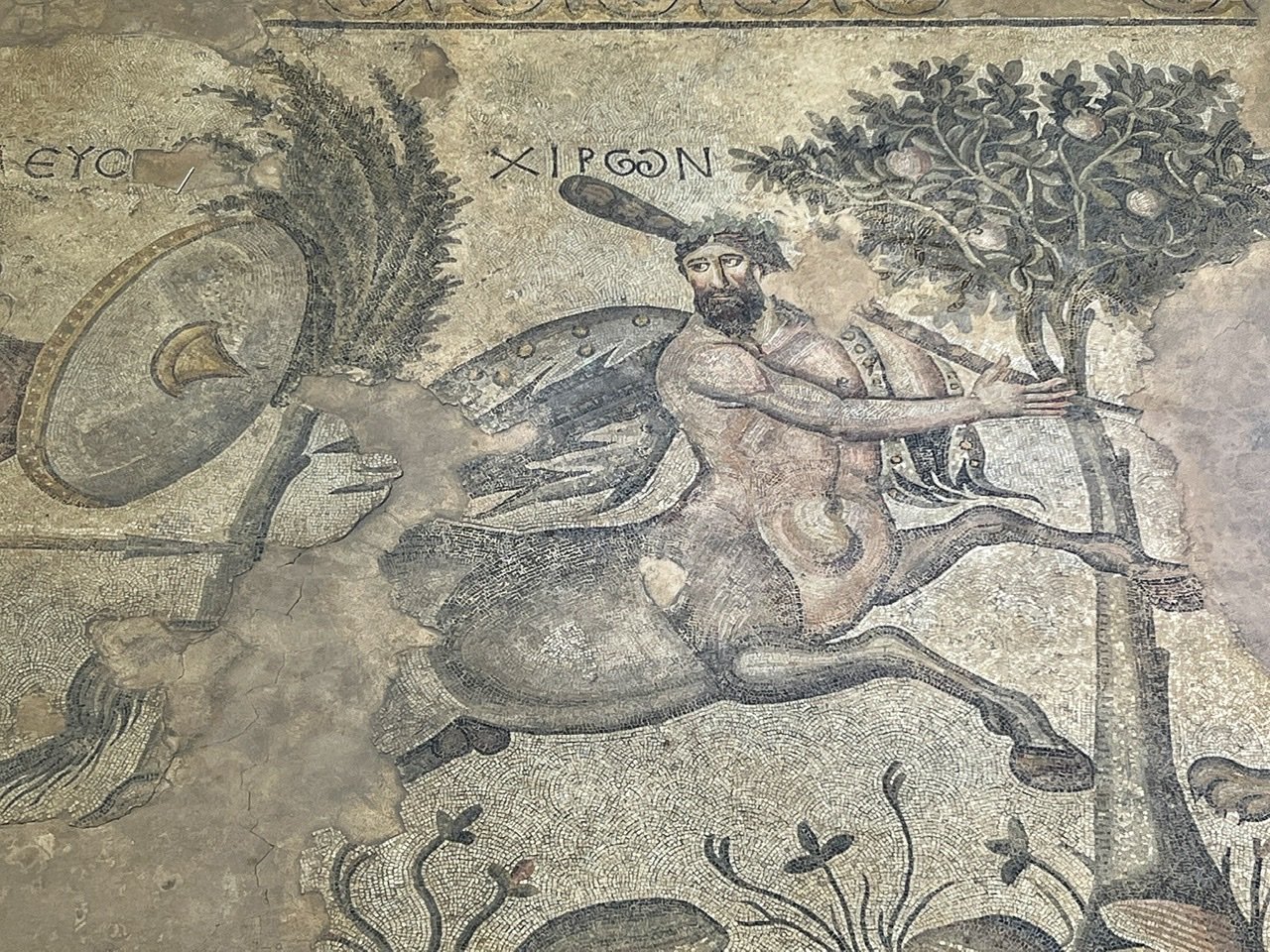
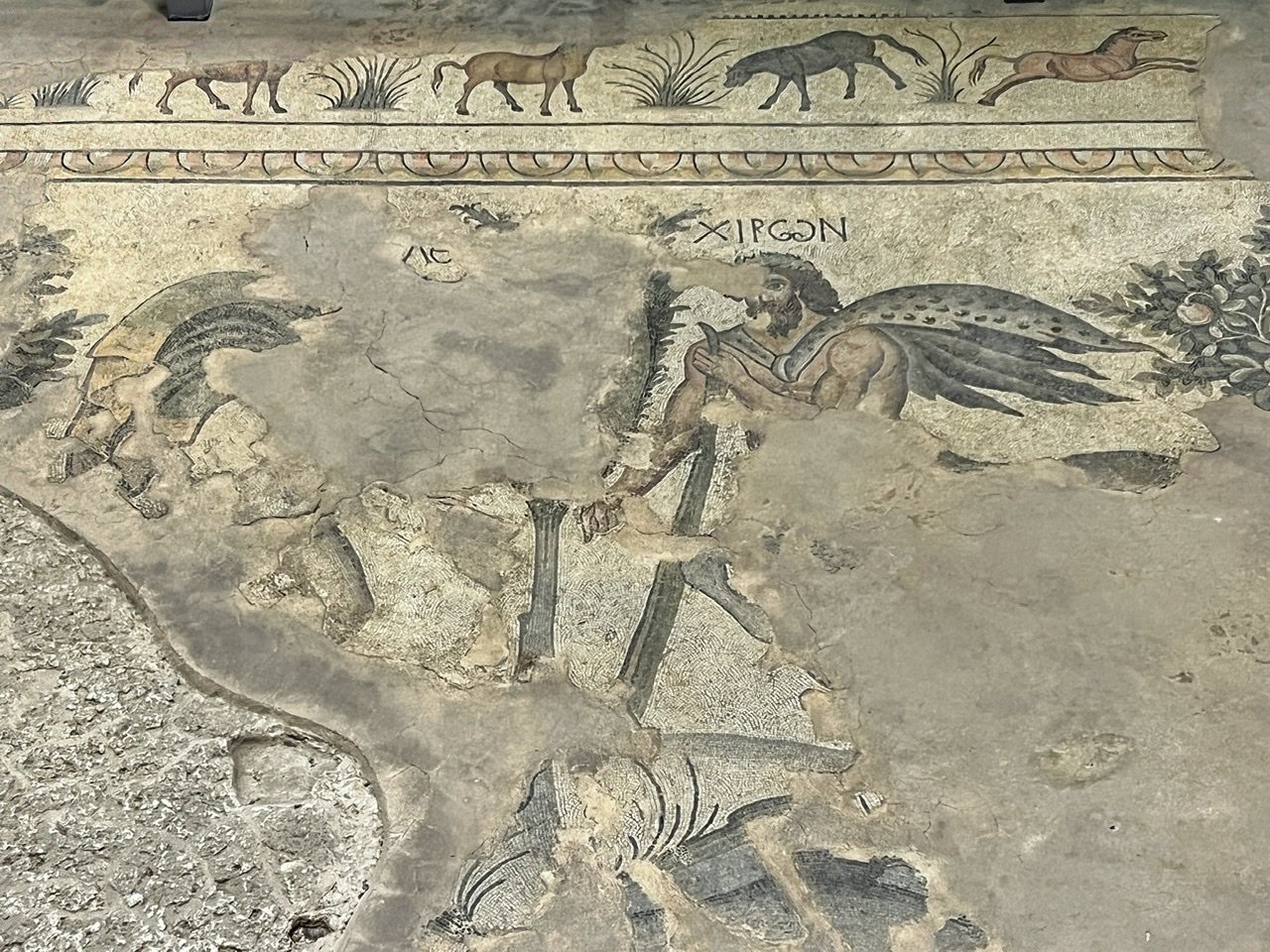
A centaur running from an unidentified flying object. Uh…or, perhaps it’s a shield.
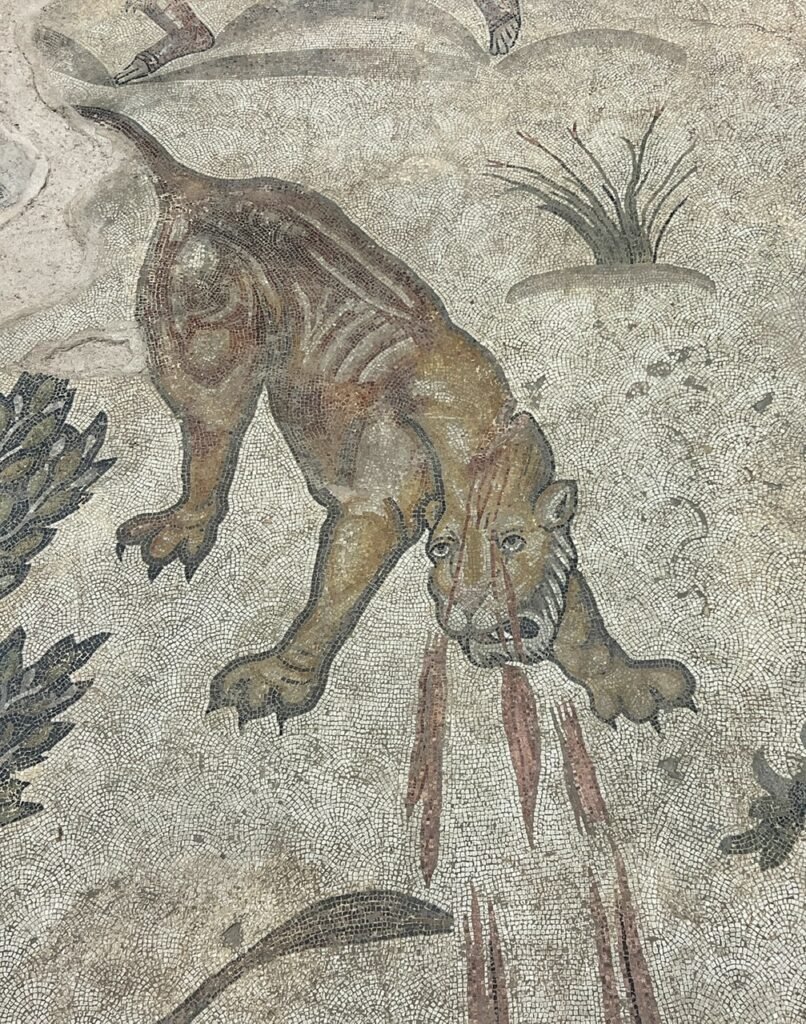
Blood thirsty lion?

And they domesticated zebras? Furthermore, zebras lived here?

You can really see the sheer size of some of these mosaics in this photo. Simply an incredible place to visit.

